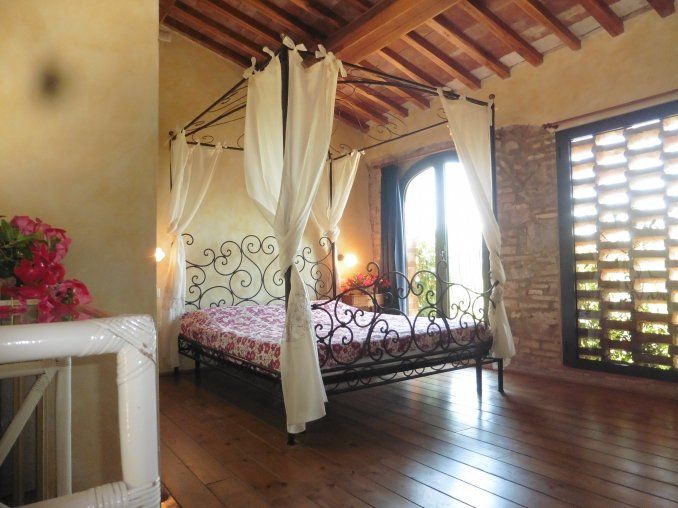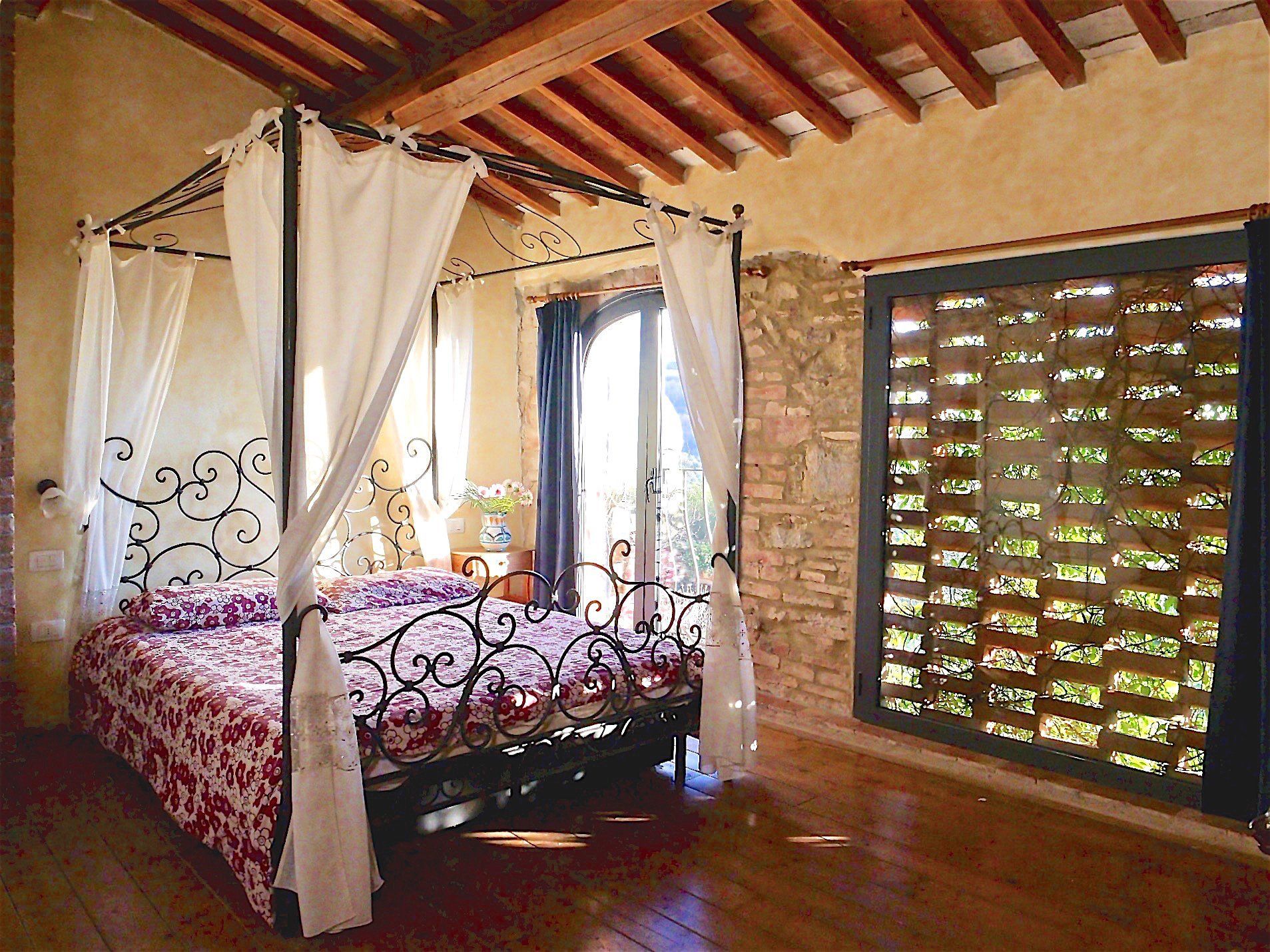
Titolo diapositiva
Scrivi qui la tua didascaliaPulsante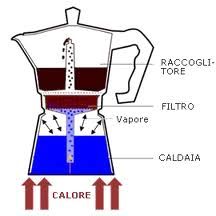
Titolo diapositiva
Scrivi qui la tua didascaliaPulsante
-
Coffee
Coffee in Italy is more than just a drink: it is a daily ritual, a cultural symbol, and a sensory pleasure.
Whether it’s in the morning to help us face the day, for a refreshing break, or at the end of a meal, coffee is always a moment of pleasure.
"Shall we have a coffee?" is the invitation that opens the door to new friendships, love stories, collaborations, and agreements.
One important thing to keep in mind when going out for coffee at a bar is that the price varies depending on whether you stand or sit. If the bar offers seating, always check with the barista beforehand if there is an extra charge for sitting down. Some places have seating without table service, meaning there are no additional costs—you just need to bring your coffee to the table yourself.
Finally, if you really want to feel like a local, consider paying for an extra coffee. In Italy, especially in Naples and its surroundings, it is a tradition to pay for a “caffè sospeso”—a “suspended coffee.” These extra coffees are then offered to those in need, such as homeless people. You are not obliged to do it every time, but if you have a lot of loose change in your pocket and want to lighten your purse, it can be a kind gesture.
In Italian bars, you can order a wide range of coffee varieties, each with its own characteristics and particularities, capable of satisfying every taste and need.
-
Espresso and Basic Variants
In Italian bars, you can order a wide range of coffee varieties, each with its own characteristics and particularities, capable of satisfying every taste and need.
Here is a complete list of the most common coffee variations available in Italian bars:
Espresso and Basic Variants
- Un caffè – This term refers to an espresso, the most commonly ordered coffee in Italy and the heart of Italian tradition. Prepared using a pressure machine that forces hot water through finely ground coffee, it offers an intense and aromatic flavor with a golden, velvety crema on top.
- Ristretto – A more concentrated version of espresso, achieved by stopping the extraction process earlier than usual. The result is a denser and more aromatic coffee with a strong, lingering taste.
- Lungo – The opposite of ristretto, a lungo espresso is made with more water, offering a milder and less concentrated taste while preserving the coffee's rich aroma.
- Doppio – Two espressos served in a single cup, perfect for those looking for an extra caffeine boost and a more intense flavor.
- Americano – An espresso diluted with hot water, similar to the drip coffee commonly found in English-speaking countries, with a smoother and less intense taste.
- Decaffeinato – For those who want the flavor of espresso without the effects of caffeine, while still maintaining the aroma and consistency of the original.
Coffee and Milk
- Macchiato – An espresso with a small amount of warm or cold milk, adding a touch of creaminess without overpowering the coffee’s intensity.
- Schiumato – Similar to macchiato but with a more generous amount of steamed milk foam, making the coffee velvety and smooth.
- Caffè Latte – An espresso served in a large cup with a generous amount of warm milk, perfect for those who prefer a milder taste.
- Latte Macchiato – Warm milk poured into a glass with the addition of an espresso, creating a layered visual effect and a balanced flavor between milk and coffee.
- Cappuccino – A classic Italian coffee made with espresso, warm milk, and a dense layer of milk foam. Traditionally consumed at breakfast, it can be customized based on the amount of milk and foam.
- Cappuccino Chiaro or Scuro – Cappuccino chiaro has more milk, making it milder, while cappuccino scuro has a higher coffee ratio, resulting in a stronger flavor.
- Caffè Mocha – A delicious combination of espresso, hot chocolate, and milk, often topped with whipped cream for an even sweeter touch.
Special Coffees
- Caffè Corretto – An espresso enhanced with a splash of liquor, such as grappa, sambuca, or amaretto, for a bold and warming taste.
- Caffè d’Orzo – A caffeine-free alternative made with roasted barley, available in a small or large cup.
- Caffè al Ginseng – A drink with a sweet, slightly spiced flavor, made with ginseng extract, known for its energizing properties.
- Caffè con Panna – An espresso served with a generous amount of whipped cream for a creamy and rich combination.
- Caffè Shakerato – A refreshing drink made by shaking espresso, ice, and sugar until a velvety foam forms, offering a well-balanced taste.
- Caffè Freddo – Chilled espresso served over ice, often sweetened, perfect for hot days.
- Marocchino – An espresso served in a glass with a dusting of cocoa powder and foamed milk, creating a perfect balance between sweetness and coffee intensity.
Service Variations
- In a Small or Large Cup – The option to choose the cup size to adjust the coffee’s intensity and volume.
- In a Glass – Many coffee variations can be served in a glass, enhancing the visual appeal and ingredient layering.
With such a wide variety of choices, coffee in Italy is not just a beverage but an experience to be enjoyed according to personal taste and moments of the day!
-
History of Coffee
History of Coffee
The history of coffee has ancient and fascinating origins, tracing back to the lands of Arabia and Ethiopia. According to legend, a shepherd named Kaldi discovered the energizing effects of coffee berries after noticing the lively behavior of his goats. From there, coffee began its journey to the Arab world, where it became a central beverage in Islamic culture.
In the 15th century, coffee spread through Arab cities, particularly Mecca and Cairo, where it was known as the "Wine of Arabia." The first coffee houses, called "qahveh khaneh," emerged in these cities, becoming gathering places for intellectuals and merchants. These establishments solidified coffee’s role as both a mental stimulant and a social drink.
It was through Venetian merchants that coffee reached Europe in the 17th century. As a major trade hub, Venice became one of the first European cities to introduce this exotic drink. Initially, coffee was regarded with suspicion by the Church, to the point that Pope Clement VII was urged to declare it the "devil’s drink" due to its stimulating effects. However, after tasting it, he approved it, and coffee quickly won over European aristocracy.
A key event in coffee’s spread across Europe occurred in 1683 during the Siege of Vienna by the Ottoman Empire. After the Ottomans retreated, 300 sacks of coffee beans were found abandoned by the invaders. Some of these sacks were left in the rain, softening the beans and making the coffee less bitter. At first, the Viennese did not know what to do with them, but a Polish man, Jerzy Franciszek Kulczycki, who had lived among the Turks, asked the commander of Vienna’s fortress for the sacks of coffee as a reward for his services. Kulczycki then opened a café in Vienna, where he served a beverage unknown to the Viennese—coffee with a bit of milk sweetened with honey, giving birth to "Viennese coffee." Coffee soon became a popular drink in Vienna.
From Vienna, coffee spread across Europe, with cafés opening in Paris, London, and Berlin. These establishments became meeting places for artists, philosophers, and politicians, solidifying coffee not just as a drink but as a cultural symbol of exchange and discussion.
Today, coffee is one of the world’s most important export products, with the majority of production taking place in South America, Africa, and Asia. Coffee beans are roasted in various ways, which affects the final taste of the beverage. Darker roasts result in a stronger coffee.
Here in Italy, coffee is often enjoyed in its pure form—without artificial flavors, whipped cream, or other additions—so it must be of the highest quality.
Nowadays, there are two main ways to prepare coffee: using a capsule or pod machine, which offers a quick, convenient method that delivers a creamy, velvety coffee similar to what you’d get at a café, or using the good old moka pot.
The moka pot is undoubtedly a more sustainable and much cheaper option compared to coffee made with a machine.
-
The Moka Pot: A Story of Italian Ingenuity
The Moka Pot: A Story of Italian Ingenuity
The name moka originates from the city of Mokha in Yemen, one of the first and most important coffee-producing regions, particularly for Arabica coffee.
This product is the result of the ingenuity and creativity of Alfonso Bialetti (1888–1970), one of the greatest Italian entrepreneurs in history. Today, the moka pot is recognized worldwide as one of the most important icons of Made in Italy, even being featured in the Triennale Design Museum in Milan and the MoMA in New York.
The brand remains the undisputed leader in the market. Over the years, the design has undergone only slight modifications, but it has retained its standard form—an octagonal aluminum body, which is one of its most distinctive features.
How It Works:
Fill the lower chamber with water up to the safety valve and fill the funnel-shaped filter with ground coffee until level. Avoid overfilling with water or pressing the coffee grounds, as this can hinder the upward movement of the liquid, prolonging the brewing time and increasing energy consumption.
Place the moka pot on the smallest burner, ensuring that the flame remains within the base's diameter.
As the moka heats up, steam forms in the lower chamber (the boiler) and remains in equilibrium with the water below at atmospheric pressure.
With rising temperature, the pressure of the steam increases (combined with the pressure exerted by the air volume inside the boiler). This pressure acts on both the boiler walls and the surface of the water.
When the pressure reaches approximately 1.2 atmospheres, it becomes strong enough to overcome gravity, pushing water and steam upward through the only available path—the filter tube.
The water and steam pass through the coffee grounds, extracting caffeine and the aromatic compounds that give coffee its rich flavor.
As the temperature continues to rise, steam and brewed coffee travel up the chimney, finally emerging into the upper chamber, where the coffee is collected.
After about five minutes, the coffee is ready. You can turn off the flame as soon as you hear the unmistakable gurgling sound, a sign that the brewing process is complete. Now, it’s time to enjoy a perfect Italian coffee!
-
Where to buy it
Caffè Moka Jenne
Niccolai di C. Cappellini srl
Via G. Innocenti 100
51100 Pistoia
tel. 0573 530458
Torrefazione Caffè New York T.N.Y. S.P.A.
Viale Adua n°5/7
51100 Pistoia
Tel: +39 0573 24281-2
Storia del caffè
1/3/2025

Slide title
Scrivi qui la tua didascaliaButton
Slide title
Scrivi qui la tua didascaliaButton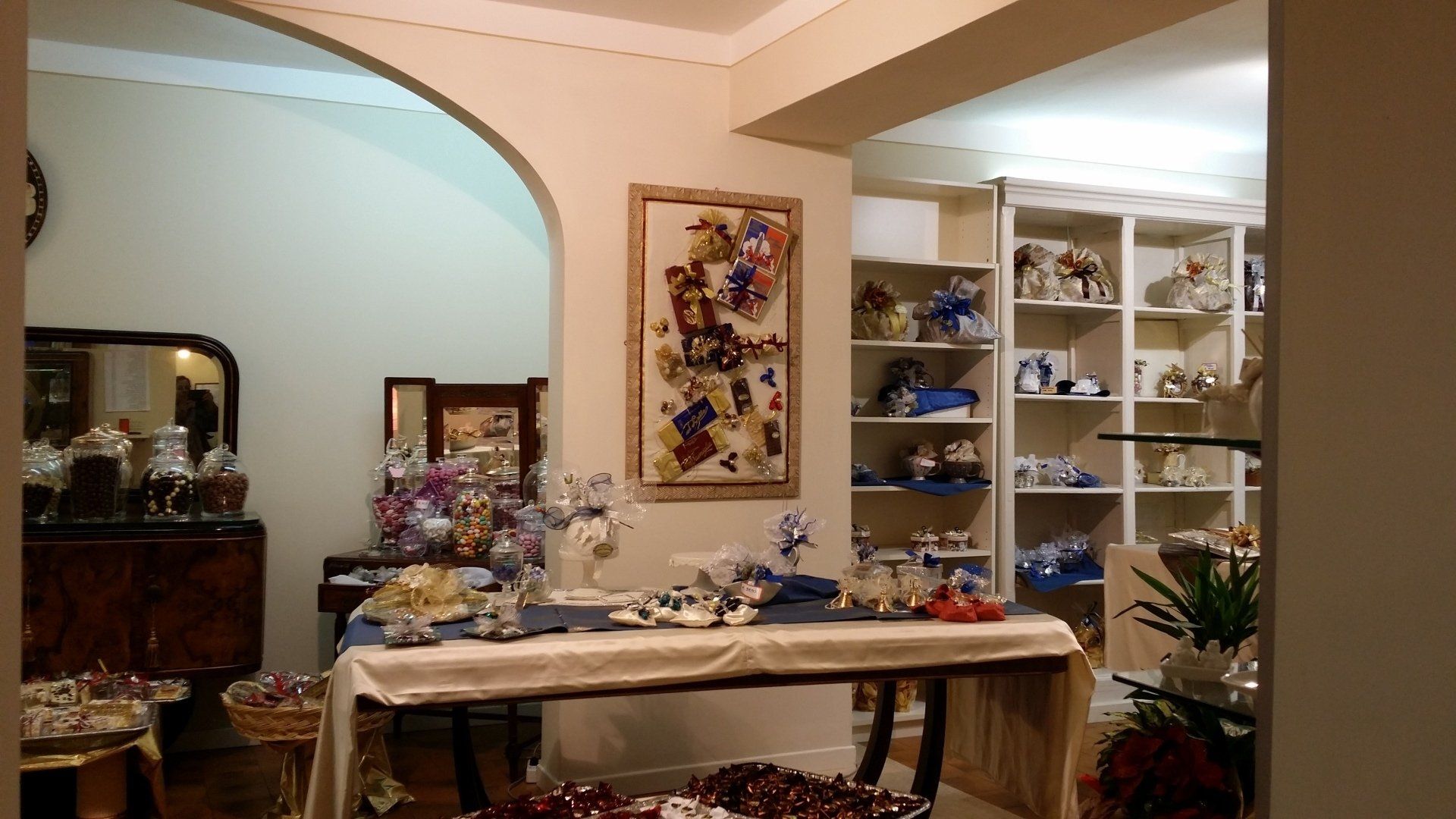
Slide title
Scrivi qui la tua didascaliaButton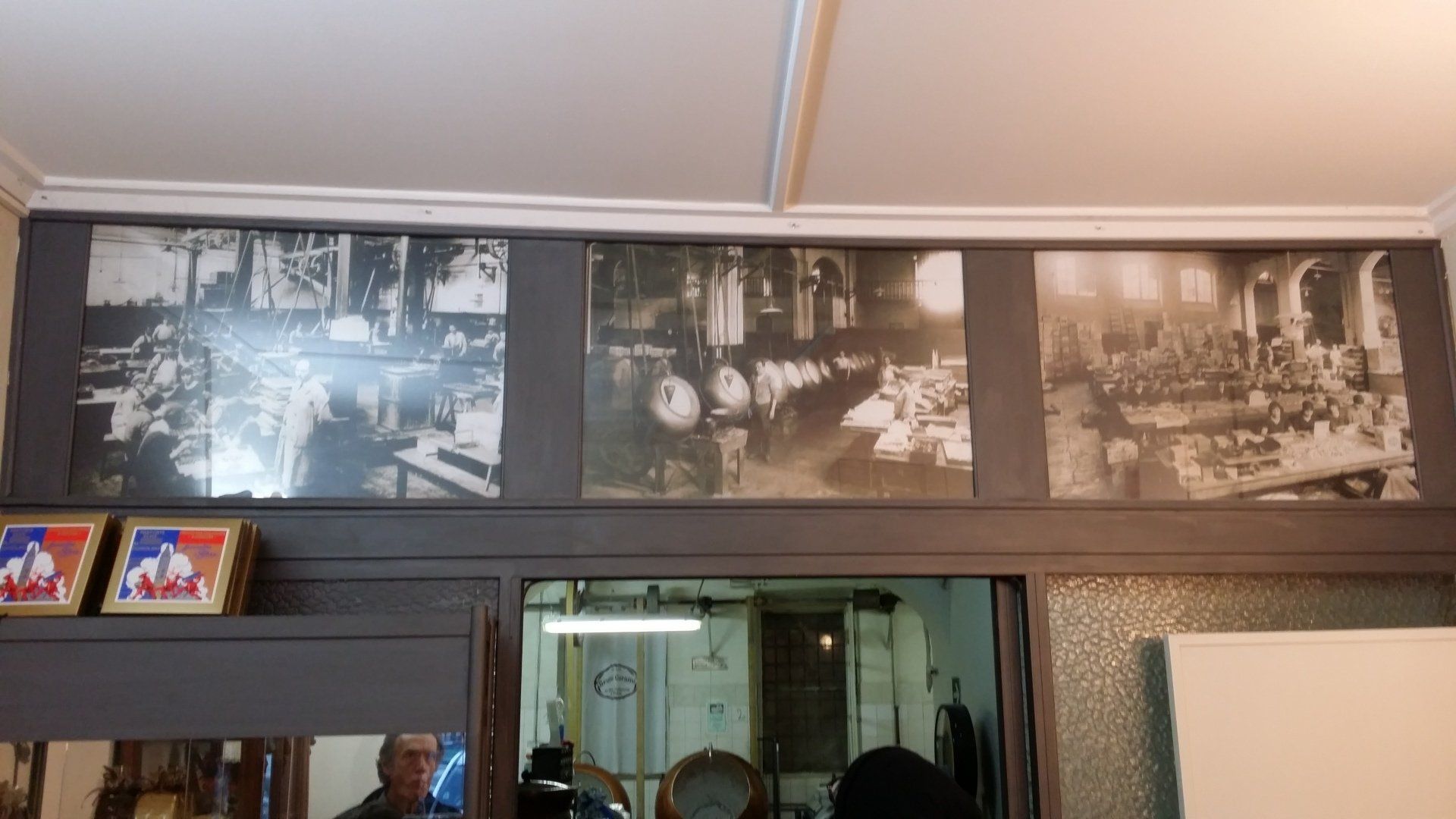
Slide title
Scrivi qui la tua didascaliaButton
-
Pistoia - The Confetto
“Birignoccoluti”, (ragged shaped) in Pistoia dialect, otherwise known as comfits, are famous in this region. The white sweets come in many sizes – 5g, 10g, 20g, even enormous 100g and 150g specimens – and their round, irregular, lumpy shape is unique. This shape dates back to the origin of the comfit, when the first ragged comfits were brought to Italy from the East by Venetian merchants between 1100 and 1200. In the Byzantine Empire, nobles often threw them down from balconies onto their celebrating subjects on feast days. The ragged shape – still characteristic of Pistoia comfits today – made them fall much more slowly. The first record of comfits in Pistoia dates back to the Middle Ages, when aniseed sweets – as they were known – were given out in the Opera di San Jacopo during a feast for religious and civil authorities on 25 July 1372, during the celebrations for the town’s patron saint. Specially produced for the powerful Opera di San Jacopo, these sweets were said to have digestive properties and help to protect against the plague.
The original recipe for Pistoia comfits called for water, honey and an aniseed seed; it was only later that almonds, candied fruit or chocolate were used. Their unusual shape is due to the method of production, which has remained unchanged since the mid-fourteenth century when, with the establishment of the first sugar refineries, sugar began to be used instead of honey. The comfits are made in rotating copper cauldrons, known as “bassine”, where the centres are first covered by a light coating of icing sugar, then sugar disolved in water is poured slowly through a funnel, first in a stream and then in drops. It takes a least ten hours to produce Pistoia comfits in this way. It is an artisan method and is lengthy and expensive when compared to other, more common bean-shaped comfits, which can be cranked out by modern machines at a rate of hundreds every few minutes. The high costs involved, coupled with a general change in customs, led to a decline in Pistoia comfit production. Whereas until the fifties wedding guests would buy kilos and kilos of comfits to throw outside the church and along the streets as the wedding convoy passed, from the sixties onwards little wedding keep-sakes – which contain few comfits – became more popular. Today in Pistoia comfits are only produced by two artisan laboratories, where this niche production is experiencing steady growth. Presented in little bags to give as gifts or in more elegant packaging, Pistoia comfits are a true delicacy which can be adapted for all occasions.
Traditional aniseed comfits help digestion when taken at the end of a meal. In the historic laboratory-shop “Bruno Corsini”, in operation on the Piazza San Francesco since 1918, as shown by the beautiful old photos from the family’s archives, you can buy original aniseed comfits as well as other variations. Giorgia Corsini, the great-grandson of founder Umberto explained that “we have recently begun to produce a new medicinal line based on ancient recipes, using fennel, cumin or coriander for the centre”. Pistoia comfits are also produced by “Confetteria Pistoiese”, a younger laboratory but with the same artisan history, which, in recent years, has opted to display a range of sweets from around the area alongside the traditional comfits.
-
Where to buy it
Today in Pistoia the comfit is produced only by two artisan workshops, a niche production, but constantly increasing. To be given in simple bags or in more elegant packages, the Pistoia comfit is a real delicacy, suitable for all occasions. The traditional one with anise, at the end of the meal, helps digestion.
In the historic laboratory - shop "Bruno Corsini", active since 1918, as evidenced by the beautiful vintage photos of the family archive, in Piazza San Francesco, it is possible to buy the original Pistoia comfit with anise, as well as other variants . Recently, as Giorgia Corsini, great-grandson of the founder Umberto tells us: “We have started to produce a new comfit variant, made from ancient recipes, with a heart of fennel, cumin or coriander”.
The Pistoia sugared almonds are also produced by the youngest, but also historic artisan production "Confetteria Pistoiese", which in recent years has decided to add a line of local confectionery products to the comfit.
Bruno Corsini Piazza
San Francesco 42, Pistoia
Confetteria Pistoiese
Via Macallè 77/79, Pistoia www.confetteriapistoiese.com
The Confetto di Pistoia - A brief history. Where to buy it
4/6/2025
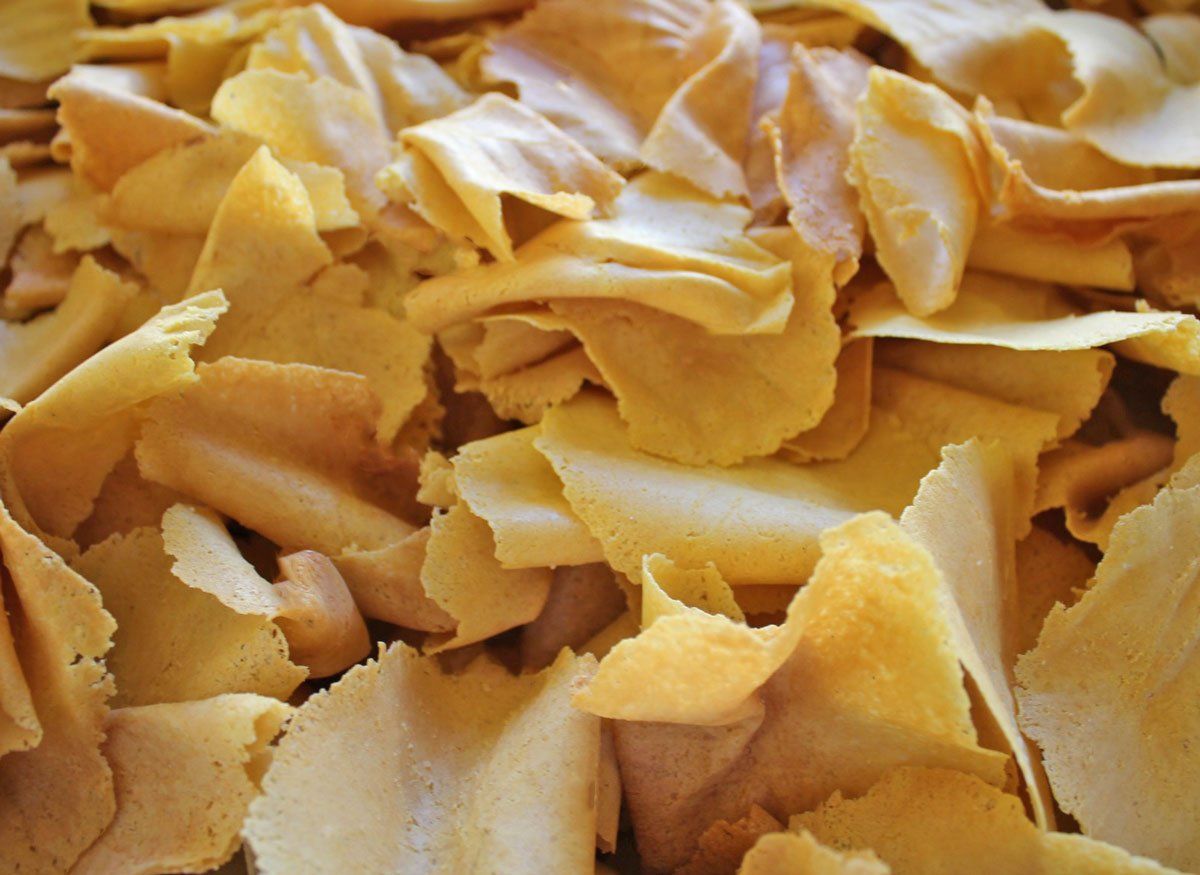
Slide title
Scrivi qui la tua didascaliaButton
Slide title
Scrivi qui la tua didascaliaButton
-
Pistoiese specialties - The Brigidino di Lamporecchio
The symbol of Lamporecchio, a small municipality of the Pistoiese Montalbano, is a small, sweet, crunchy wafer with a unique and unmistakable flavour: the brigidino.
There are only a few people who haven’t heard of them as they are generally found on stalls at fairs and festivals all over Italy, and you can’t go far wrong with them. These wafers, with an aniseed aftertaste, are so famous that they have even been mentioned in Crusca’s dictionary.
The Brigidino is a round wafer with a diameter of approximately 7 cm, thin like a host wafer and decorated at the edges. Brittle and crunchy, it has an unmistakable orangey-yellow colour and a unique flavour of aniseed combined with sweet pastry made of sugar, flour and eggs. Manufacturing dates back to the Renaissance period. There are various hypotheses regarding its name, but the most established one says that the name comes from the “brigidine”, nuns of a local convent devoted to Santa Brigida. Traditionally in charge of the preparation of the hosts for the communion, these nuns invented the recipe for these wafers towards the mid 16th century, which did not randomly have the shape of the hosts given that they were made by pressing the pastry between circular red hot iron plates. This similarity has fed a legend over the years; the brigidini were born by error. Everything began with an error by a Brigida nun who made a mistake while she was preparing the mixture for the hosts. So that they didn’t waste the mixture, the sisters decided to refine it by adding aniseeds. This is how that “special amusement” was created as defined by Pellegrino Artusi in 1851 in his famous volume “Science in the Kitchen and the Art of Eating Well”. Error or not, the success of the brigidini was immediate and it spread throughout the Pistoiese area, but Lamporecchio has always remained as their place of production, as testified by an old Tuscan saying “all Brigidini come from Lamporecchio”. They immediately became an essential feature at fairs and peasant festivals as is still the case today.
-
Where to buy it
It is sold at all local festivals and fairs.
4/6/2025
The Brigidino of Lamporecchio. Brief history and where to buy it
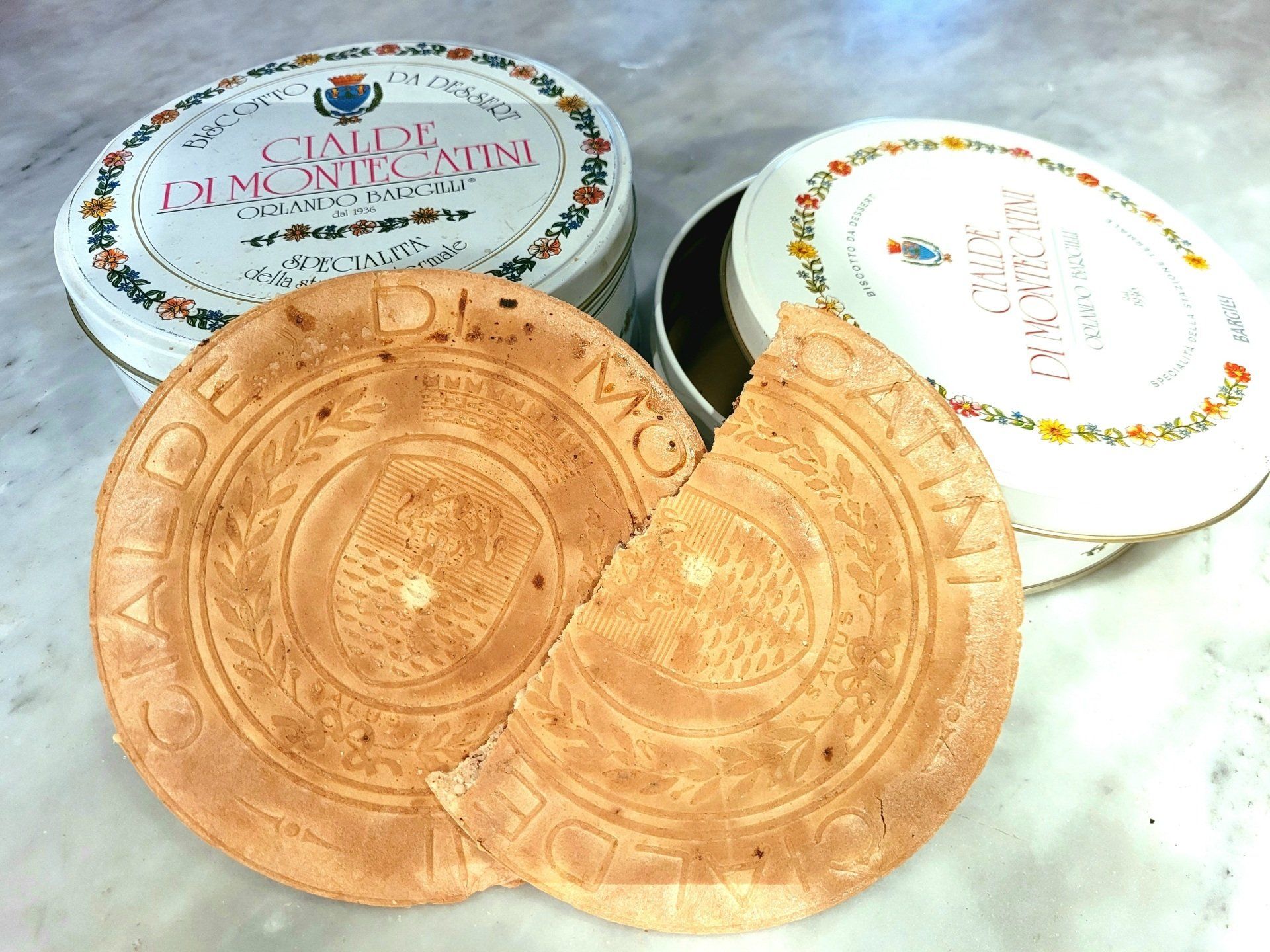
Titolo diapositiva
Scrivi qui la tua didascaliaPulsante
-
The Cialda (waffle) of Montecatini Terme
A simple and tasty recipe, handed down for generations: the Montecatini Terme waffle - two thin discs, filled with almonds and sugar - is one of the symbols of the gastronomic culture of the city.
Born in 1936 in the Bargilli laboratory, which personalized it by imprinting the family crest on it, the Cialda di Montecatini is still today one of the most sought-after products and cannot be compared to any other dessert.
The skilful mixing of the ingredients, all absolutely natural, the particularity and complexity of the processing - two thin discs obtained with a first cooking for the puff sheet only and then a second with the addition of an exquisite filling of almonds and sugar, give a compact and crumbly wafer that comes from the imagination of a family of skilled pastry chefs.
Perfect for breakfast, or as a dessert at the end of a meal to be enjoyed with ice cream, tea, but above all with a glass of vin santo in the company of friends or in the intimacy of the family.
-
Where to buy it
Bargilli - Cialde di Montecatini
Viale Verdi, 92
51016 – Montecatini Terme (PT)
The Cialda (waffle) of Montecatini Terme - Description and short history
28/1/2025
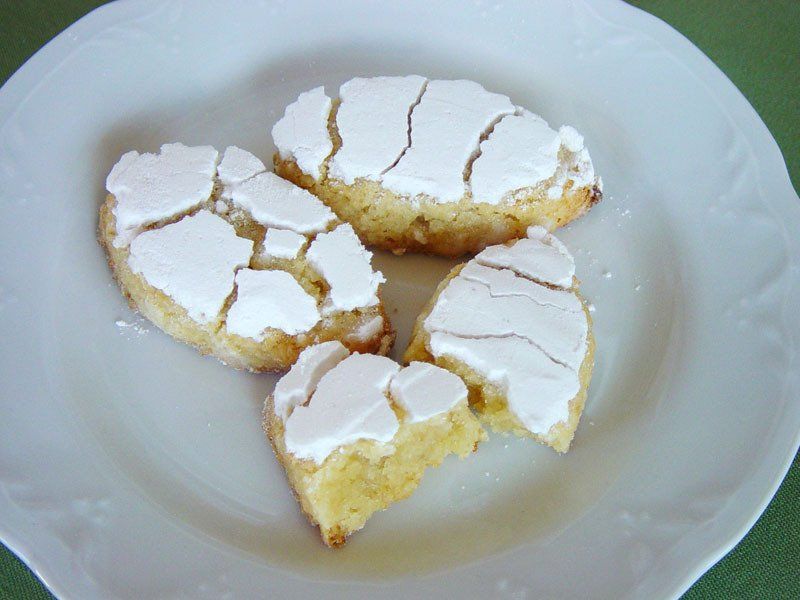
Slide title
Scrivi qui la tua didascaliaButton
-
Siena - the Ricciarelli
Siena is with no doubt the sweetest town of Tuscany!
The products of its confectionery are famous all over the world.
And the Ricciarelli, along with Panforte, are perhaps the most famous ones from Siena. The origin of these delicious biscuits is exotic because their taste and smell remind of the East.
According to the legend a Sienese crusader, Ricciarello della Gherardesca, coming back to his castle near Volterra after fighting in the Holy Land, brought the recipe of these foreign biscuits, the shape of which reminded of the Turkish sleepers.
According to a folk tradition it seems they are the result of a mistake! In the convent of the Servants of Mary, an impatient nun put to dry the traditional marzipan biscuits at a temperature too high, cooking them too much and change them into crunchy and curling “ricciarelli”.
Ingredients: sweet almonds, sugar, baking powder, cinnamon, salt, eggs, wafer, honey.
Preparation: Grind the almonds and mix them with the egg white, honey, sugar, baking powder and the spices. Mix well the dough and shape the biscuits with the ricciarelli mould. Put them on a baking-tin, sprinkle with icing-sugar and cook up to 180°C for about 25 minutes.
-
Where to buy them
In our opinion, one of the best places in Siena to buy artisanal Ricciarelli is:
La Nuova Psticceria
Via Giovanni Duprè 12
Siena
Here you can also find the Panforte.
Siena - The Ricciarellis. Brief history and where to buy them
4/6/2025
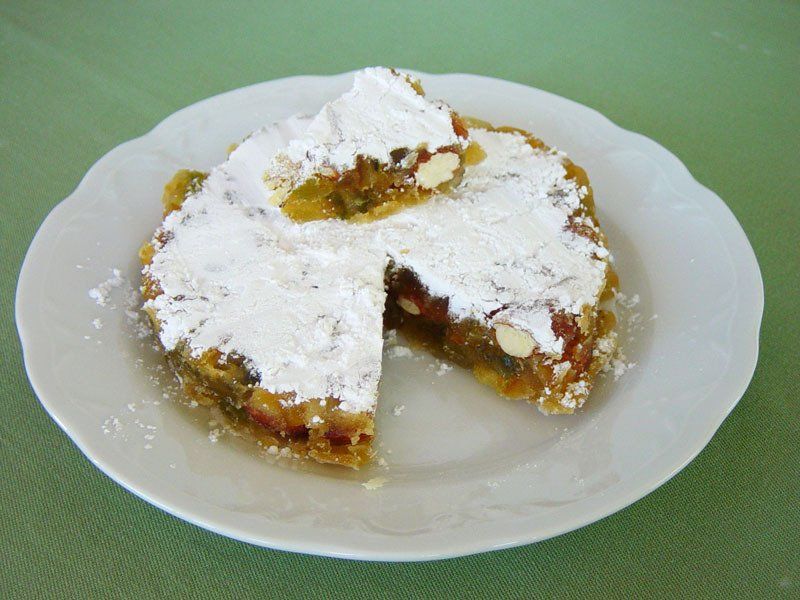
Slide title
Scrivi qui la tua didascaliaButton
-
Siena - the Panforte
The Panforte di Siena is the typical cake of the city, known since the Middle Ages. In origin it was a simple cake, prepared with flour and honey; then it was added the fruit, usually grape, almonds and figs, and, after the discovery of the spices, also cinnamon, nutmeg, coriander, pepper (for this reason the other name of Panforte is PanPepato). The recipe of PanPepato did not have modifications and the ingredients had remained the same until the year 1879, when the Queen Margherita arrived in Siena. For this occasion a chef prepared a sweeter Panforte, with vanilla, that he called Panforte Margherita (or white Panforte). This cake is usually served with sweet wines, as the vinsanto.
-
Where to buy it
In our opinion, one of the best places in Siena to buy artisanal Ricciarelli is:
La Nuova Psticceria
Via Giovanni Duprè 12
Siena
Here you can also find the Ricciarelli.
4/6/2025
Siena the Panforte. Brief history and where to buy it
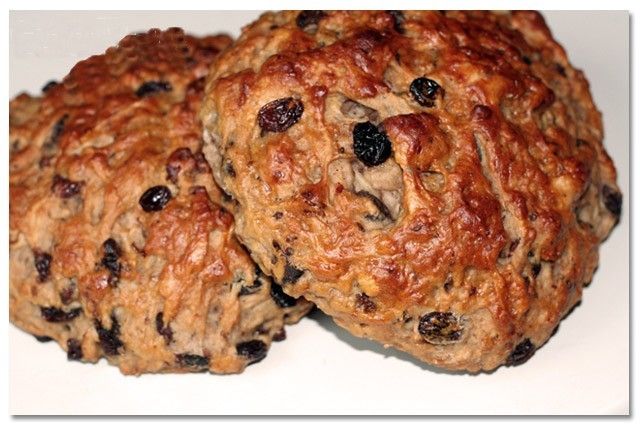
Titolo diapositiva
Scrivi qui la tua didascaliaPulsante
-
Siena - Pan Co' Santi
Pan co’ Santi: History, Tradition, and Preparation
Pan co’ Santi, also known as Pancosanti, Pan dei Santi, or Pan dei Morti, is a traditional Sienese sweet bread associated with All Saints' Day. It is a dense, slightly sweet, and spiced bread enriched with abundant walnuts, raisins, and a touch of black pepper. This product of peasant tradition encapsulates the flavors and aromas of autumn, evoking memories of home, family Sundays, and togetherness.
Its rustic, crispy crust, glazed with egg yolk, pleasantly contrasts with its soft, fragrant, and flavorful interior. The original recipe includes an artisanal dough made from wheat flour, water, yeast, a bit of sugar, black pepper, walnuts, and raisins, with the addition of lard or, in modern variations, extra virgin olive oil.
Preparation: Simplicity and Patience
Preparing Pan co’ Santi is a simple yet meticulous process. It begins with the basic ingredients of bread: water, flour, and yeast, which are left to rise. Then, high-quality walnuts, raisins, black pepper, a pinch of salt, and a fat (traditionally lard, but often replaced with olive oil nowadays) are added to the dough. After a second rise, the loaves are ready to bake.
While many enjoy it fresh from the oven, warm and fragrant, its flavor truly shines the day after baking, when the aromas have fully melded. The key to a successful Pan co’ Santi lies in the balance of ingredients and the abundance of "santi," or saints—walnuts and raisins: the more generous, the better the result.
Origins and Symbolic Meaning
The origins of Pan co’ Santi are uncertain, but it is believed to date back to the early 19th century. It was a rich and nourishing food created to compensate for the fasting traditionally observed on All Saints’ Day. At that time, it was not considered a dessert but rather a substantial dish combining bread with other ingredients.
Some scholars suggest its roots go even further back to ancient Greece, where a similar bread of the dead—likely unsweetened—was offered to Demeter as a token for a good harvest. In more recent history, particularly in rural Siena and up until the post-war period, people prepared ciaccino co’ santi (a rustic focaccia) using bread dough enriched with lard, pepper, walnuts, and raisins dried in vin santo. This was often enjoyed with new wine.
In the 1960s, the recipe evolved into the baked sweet bread we know today. With the addition of sugar, Pan co’ Santi earned the PAT (Traditional Agri-Food Product) recognition, symbolizing Sienese gastronomic culture.
Seasonality and Variations
Traditionally, Pan co’ Santi is associated with the autumn months, with peak consumption around November 1st. While it was originally baked only for All Saints’ Day, increased demand has extended its availability from September to the Christmas season.
Every bakery and artisan shop offers its own version, often passed down through generations. These variations range from rustic and hearty to softer and more refined, catering to the tastes of those who prepare and enjoy it.
How to Enjoy It: Pairings and Creative Ideas
Pan co’ Santi is incredibly versatile. In its more rustic and spiced version, it pairs beautifully with aged cheeses, chicken liver pâté, or roasted meats. In some local traditions, slices of lightly toasted Pan co’ Santi are served alongside meat dishes.
The sweeter, softer variations are perfect for breakfast or an afternoon snack, perhaps accompanied by a cup of tea or coffee. This bread also lends itself to creative culinary interpretations, such as serving it as the base for an original tiramisù, with slices soaked in vin santo instead of the traditional ladyfingers.
A Symbol of Tradition and Pride
Beyond its unmistakable aroma and rich flavor, Pan co’ Santi is a cultural treasure for the people of Siena. It is a dessert that tells stories of family, autumn, and hospitality, shared with anyone visiting Siena during this time of year. Each bite is a journey into tradition, a small piece of history renewed with every generation.
Where to find it
In Siena, from autumn until the Christmas holidays, every bakery and pastry shop offers its own version of Pan Co' Santi.
Siena - il Pan Co' Santi
13/12/2025
Slide title
Scrivi qui la tua didascaliaButton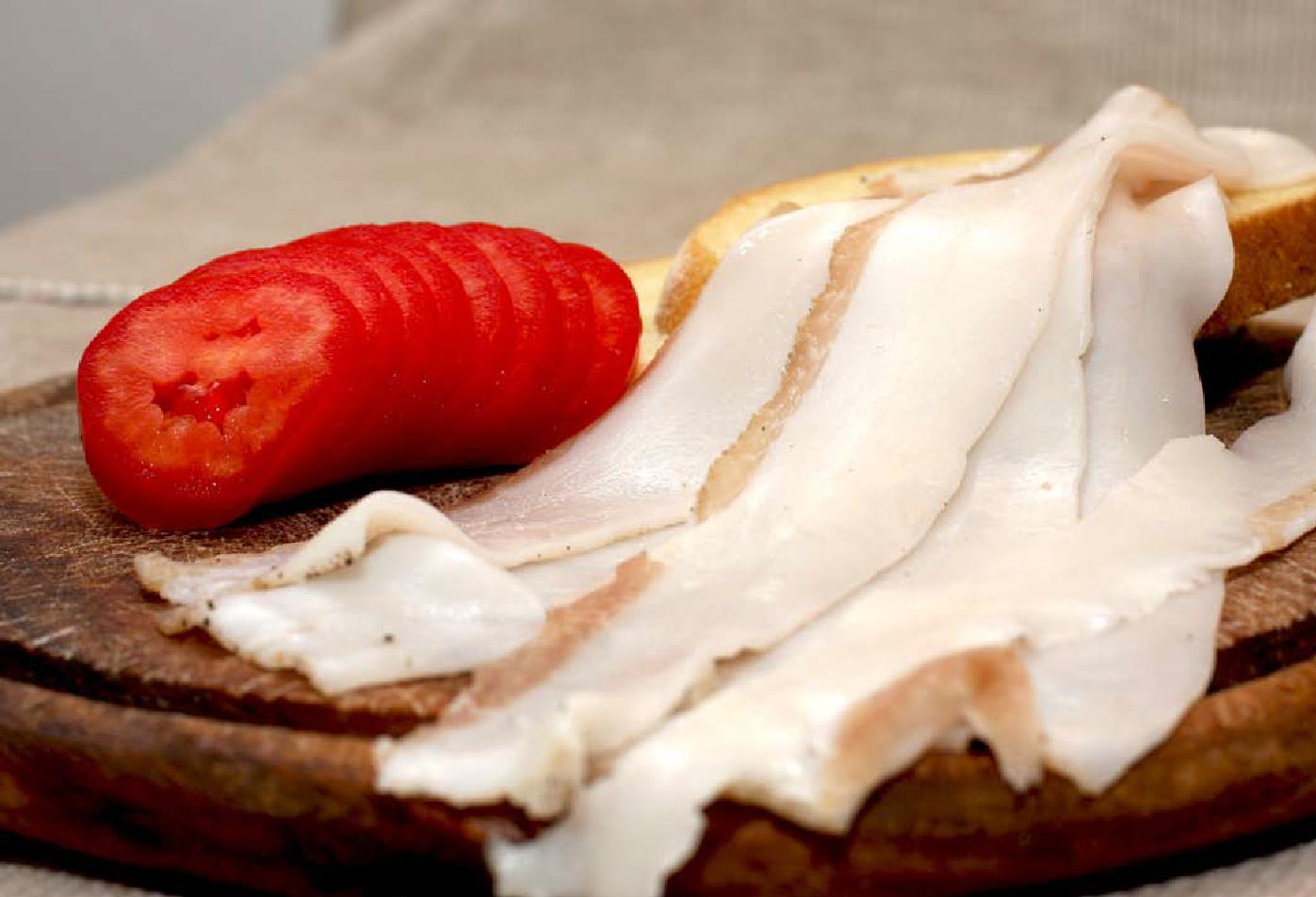
Slide title
Scrivi qui la tua didascaliaButton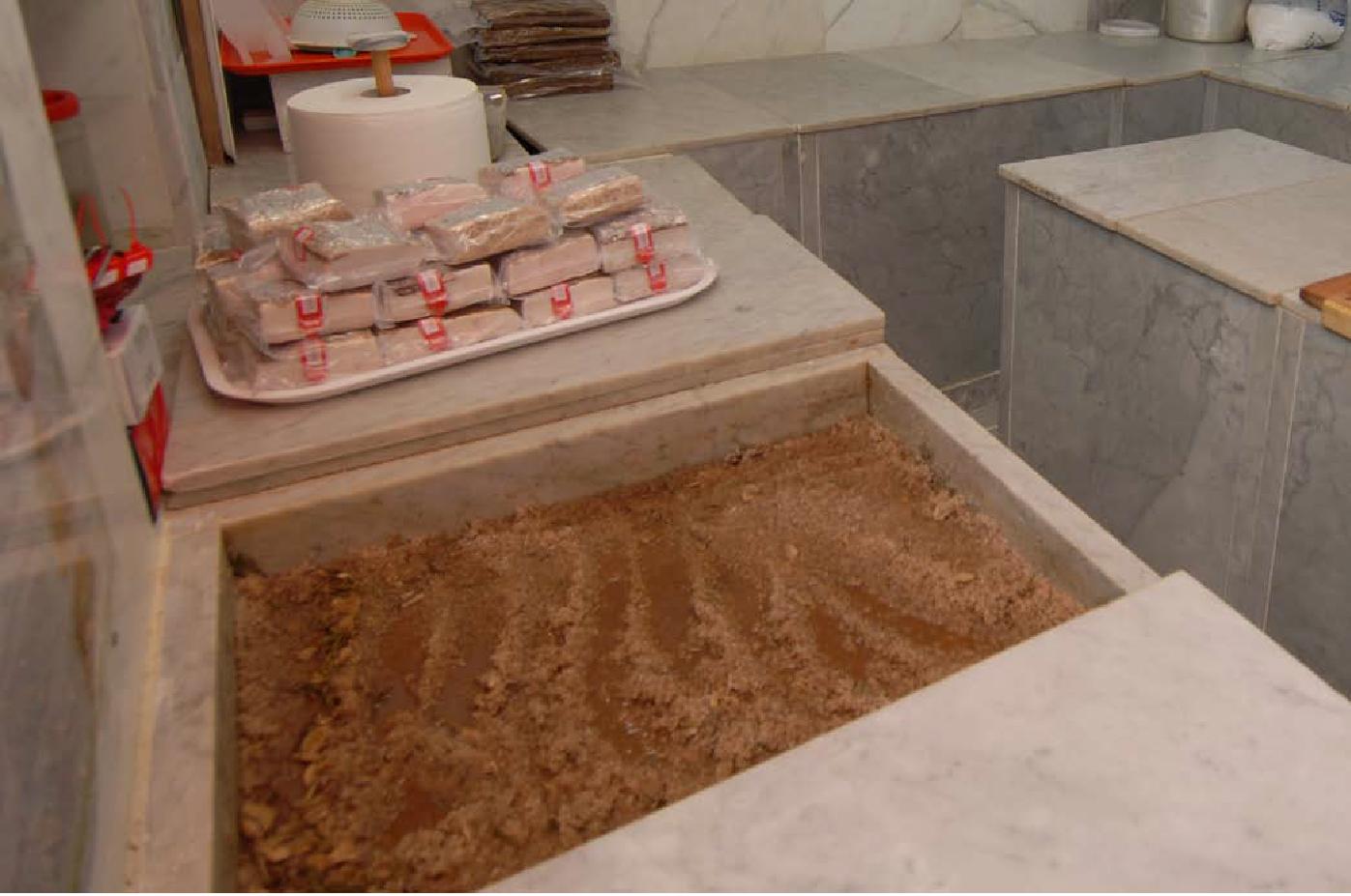
Slide title
Scrivi qui la tua didascaliaButton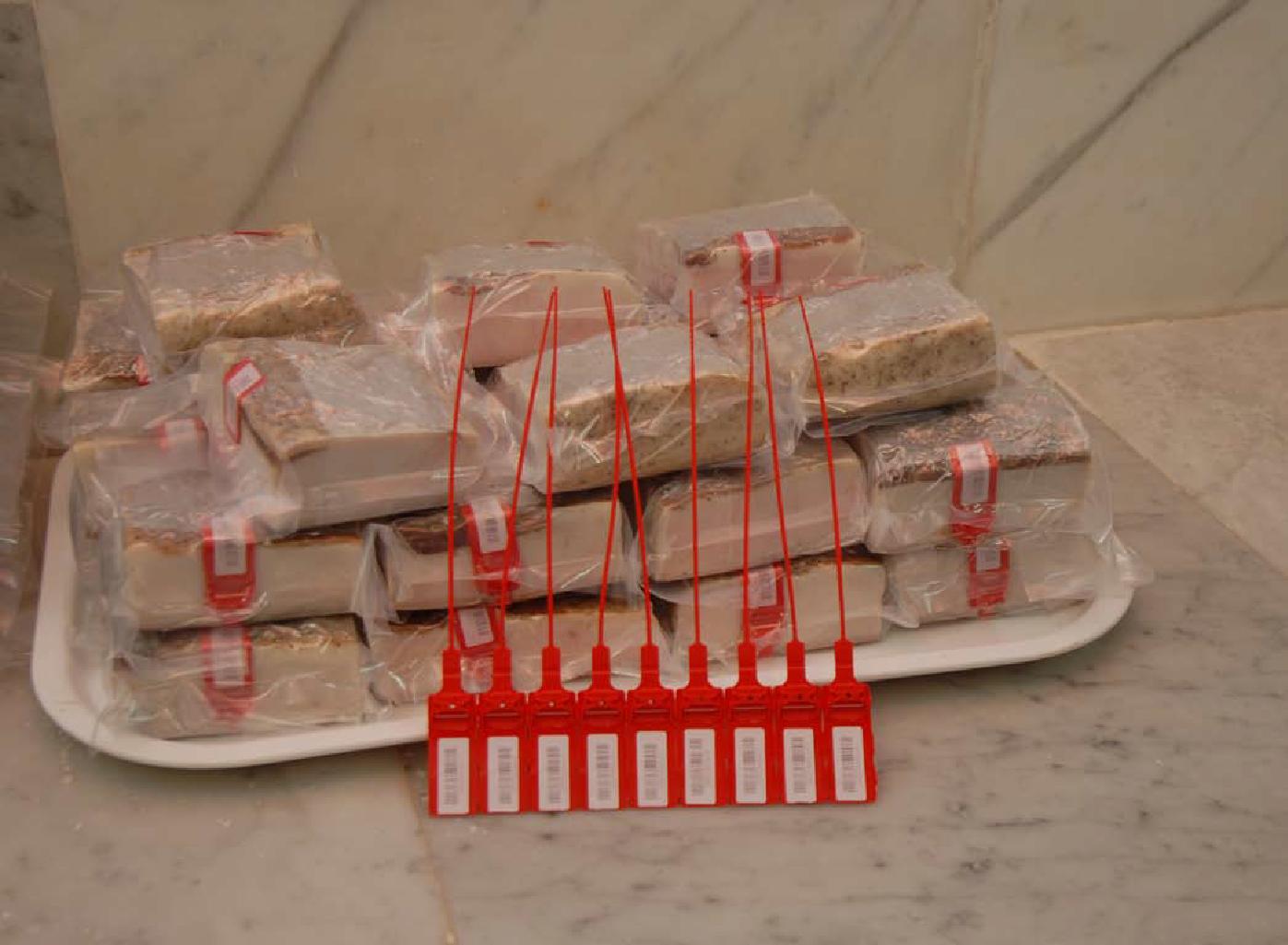
Slide title
Scrivi qui la tua didascaliaButton
-
Lardo di Colonnata
Colonnata is a small village at the feet of the Apuan Alps, in the province of Massa Carrara, known for its marble caves and the production of a characteristic cured meat once used as the traditional bread and butter of the quarrymen: the lard of Colonnata. Today the lard is one of the highlights of typical Tuscan products, one of the most delicious and delicate cured meats derived from pork processing. Traditionally sliced thinly and then eaten with toasted bread or fresh tomatoes, this tasty morsel has a unique recipe that is deeply linked with the area. The lard is obtained from the fatty layer of the pig’s back, accurately trimmed and processed according to an old tradition and secular experience. The most unique element is the seasoning in suitable marble bowls, where the lard is laid down in layers with garlic, flavourings, coarse sea salt, black pepper, rosemary, sage and other herbs, and kept for at least six months. The unique preparation and therefore the typicality of the cured meat is associated with the particular characteristics of the transpiration and impermeability of the marble extracted in the Colonnata area. The lard has in fact been certified as a Igp product (Protected geographical indication).Its processing system, unchanged for hundreds of years, was the cause of a long diatribe for the protection of hygiene standards and the organoleptic composition of the product, but in the end the value of history and tradition prevailed over everything else.
Colonnata is a village at the foot of the Apuan Alps, in the province of Massa Carrara, known for its marble quarries and the production of a characteristic salami once used as a traditional accompaniment by quarrymen: the lard of Colonnata. Lard is today one of the spearheads among the typical Tuscan products, one of the best and most delicate cured meats deriving from the processing of pork. Traditionally sliced thinly and then enjoyed together with toasted bread or fresh tomato, this delicacy has a unique recipe deeply linked to the territory. Lard is obtained from the fatty layer of the pig's back, carefully trimmed and processed according to an ancient tradition and centuries-old experience. The completely unique element is the maturation in the special marble basins, where the lard is laid in layers together with garlic, herbs, sea salt in grains, black pepper, rosemary, sage and other aromatic herbs, and stored for at least six months. The typicality of the preparation and therefore of the salami is linked to the particular characteristics of transpiration and impermeability of the marble extracted in the Colonnata area, the lard has in fact been certified as an IGP product (Protected Geographical Indication). Its processing system, unchanged for hundreds of years, has been the reason for a long diatribe for the protection of the hygiene and organoleptic composition of the product, but in the end the value of history and tradition prevailed over the rest.
-
Where to buy it
Lardo di Colonnata is highly appreciated and widespread throughout Tuscany. It is easily found in every gastronomy, even in supermarket delis.
4/6/2025
Lardo di Colonnata. Brief history and where to buy it
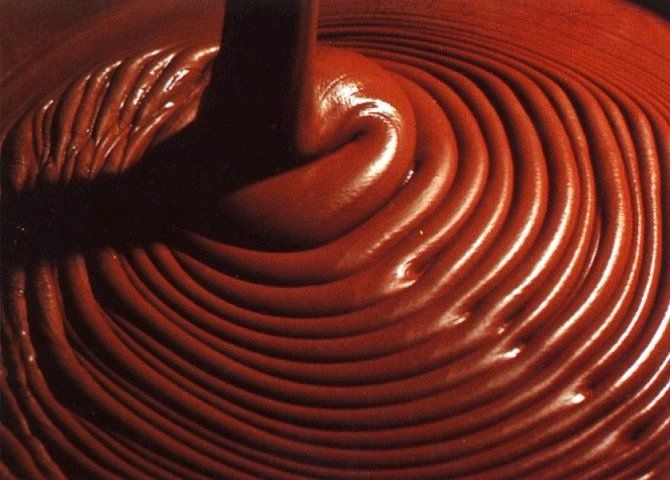
Slide title
Scrivi qui la tua didascaliaButton
Titolo diapositiva
Scrivi qui la tua didascaliaPulsante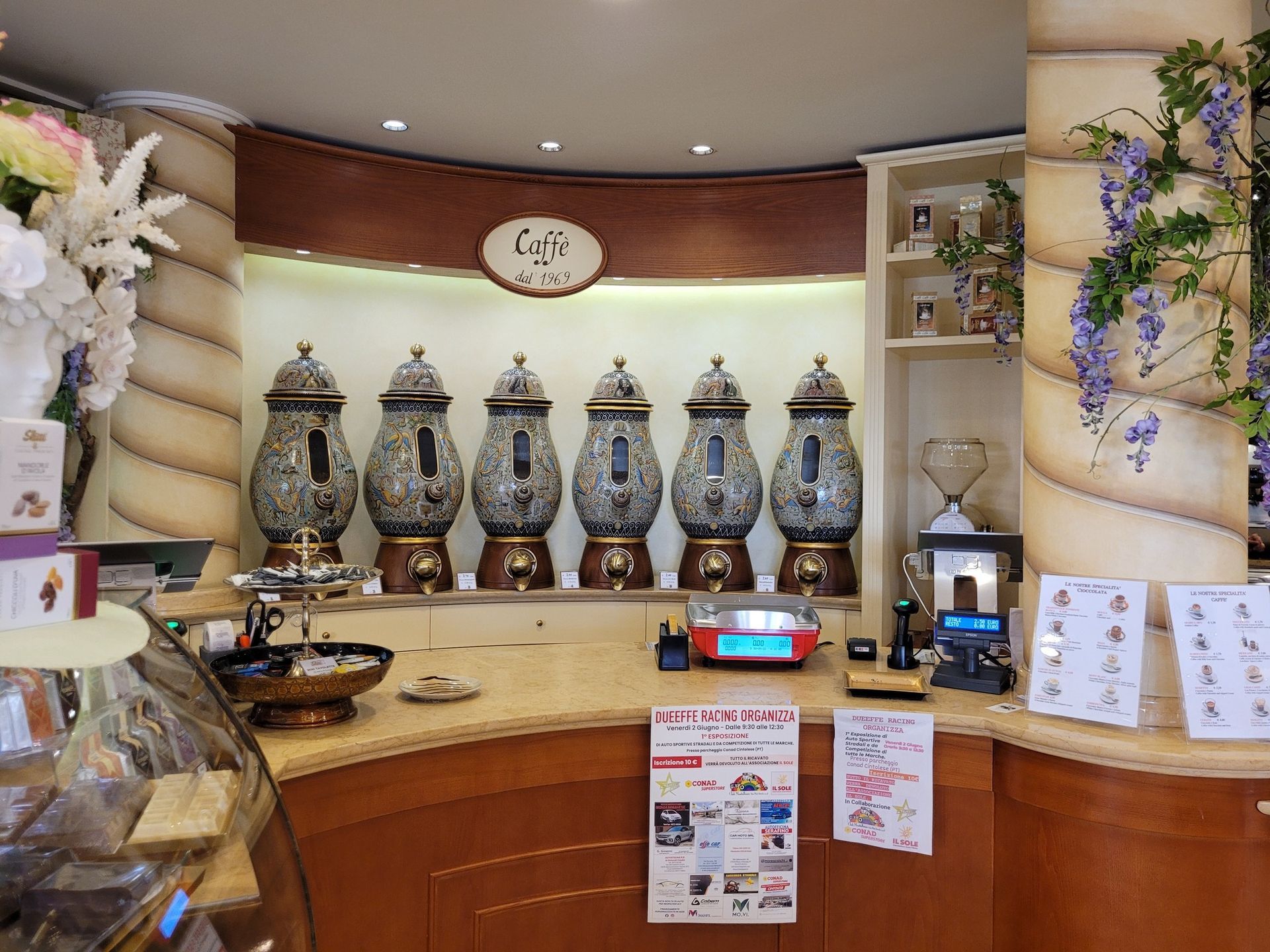
Titolo diapositiva
Scrivi qui la tua didascaliaPulsante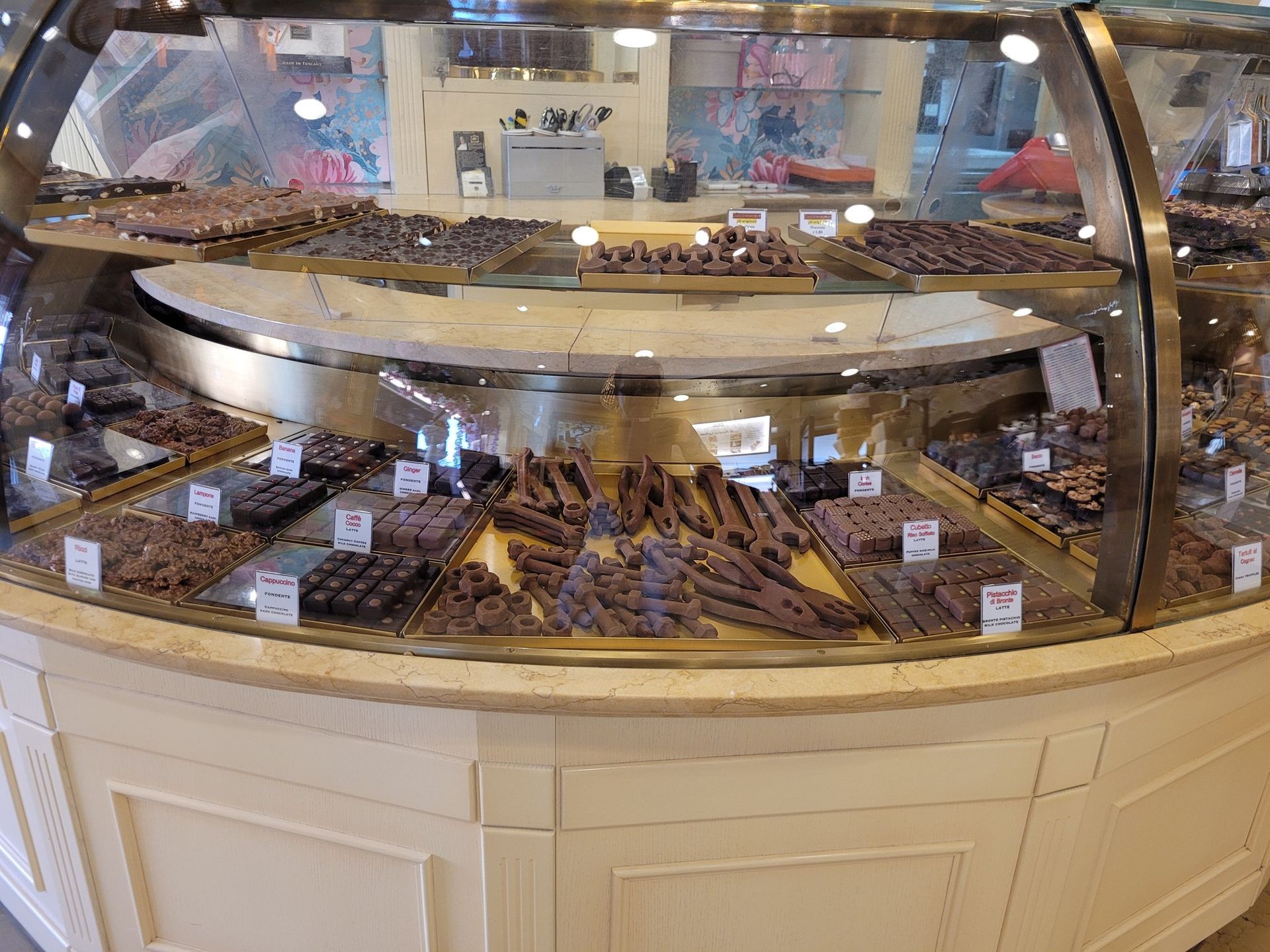
Titolo diapositiva
Scrivi qui la tua didascaliaPulsante
Titolo diapositiva
Scrivi qui la tua didascaliaPulsante
-
Chocolate Valley
When it comes to Chocolate Valley many think of exotic places, maybe in tropical countries where cocoa is produced. The Chocolate Valley instead is a part of Tuscany that stretches from Florence to Pisa, which has become popular in recent years due to the birth of many industries chocolate of the highest quality, full of artisans capable of achieving excellent products based on cocoa and chocolate, become famous and sought-after in the world despite the very limited production. In fact, this is where all the "minds" that gave way to the Tuscan chocolate to become famous throughout the world, promoting the idea of chocolate innovation, founded on a high level of quality. On the other hand, the role of innovator of Tuscany in chocolate was already known in the '600 when the Florentine Francesco D'Antonio Carletti (1573-1636) was among the first to import at home the prized product. In Florence, the consumption of chocolate has prevailed since the beginning and they were just the first great admirers of the Medici, at whose court Francesco Redi, chief physician and scientist, was delighted to prepare it in different recipes. Florence was, therefore, before Turin, Venice and Rome, to establish itself as one of the main centers of consumption and innovation in the field of chocolate processing. For this reason since the nineties of the last century, this Tuscan valley has been chosen by numerous chocolatiers as place of business, giving way to the Tuscan chocolate to become famous abroad. The quality of Tuscan chocolate was born in response to the decisions of the European Parliament authorizing the addition of vegetable fats to cocoa butter, allowing the use of genetically modified organisms, without having to declare it on the label.
-
Where to buy it
The master chocolatier Andrea Slitti is considered by all to be an innovator both for the care he gives to his products and for the innovative manufacturing processes aimed at enhancing all the scents and aromas of cocoa.
He has won many competitions in which he participated, the most recent of which was the First Prize of the World Chocolate Awards in October 2012 in London with his fabulous “Riccosa” spread and the Grand Bouquet “CaffèLatte” chocolate.
A visit to his shop which is about 10 km from the Agriturismo I Pitti and 15 km from Casa Rowe B & B is a "must" for all those who love chocolate and are looking for a truly special gift to take home.
Slitti Chocolate and Coffee
Via Francesca Sud 1268
51015 Monsummano Terme
Chocolate in Tuscany. Brief History of the Chocolate Valley. Where to buy it.
21/1/2025
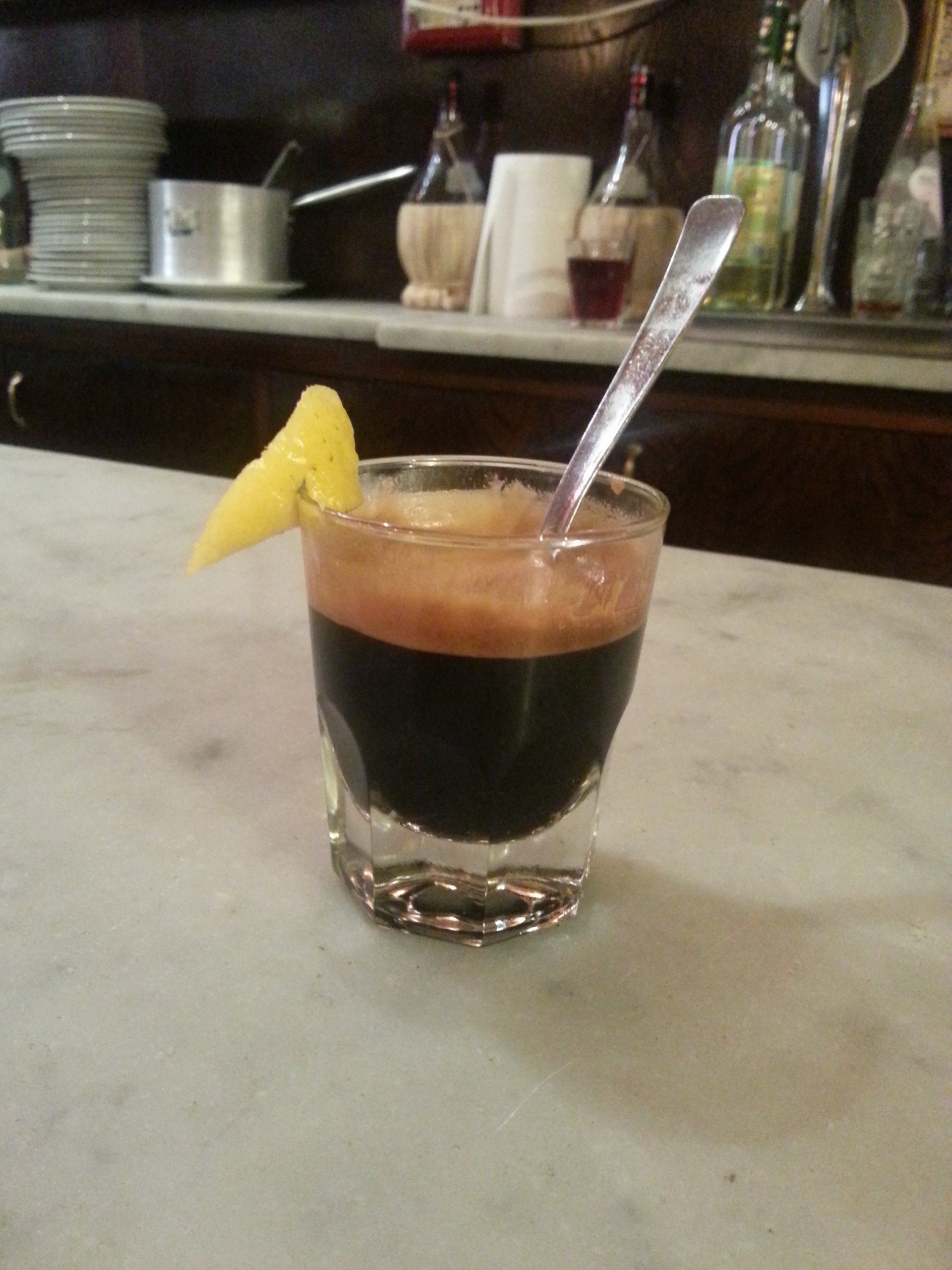
Slide title
Scrivi qui la tua didascaliaButton
-
Livorno - The Ponce
The port of Livorno had already become the gateway to and an emporium in the Medici's Grand Duchy of Tuscany when, one morning in 1674, a Saracen felucca docked there, laden with coffee and barrels of rum.
The mysterious scented coffee beans immediately aroused the interest of several innkeepers who tried to use them in their taverns. They added hot rum to produce a strong, restorative drink for the shivering sailors forced to stay on land because of bad weather.
This is how ’il ponce’ began, and what an invention! The truly explosive combination, capable of comforting souls and helping in difficult moments, is so unique that it still plays a dominant role in the lives of every Livornese
family, representing a highly satisfactory way of rounding off a fine meal.
However, Livorno is not just the city that invented ’il ponce’: in the 1800’s the first cafés opened here, frequented by people from all social classes and cultural backgrounds, as well as by women - an important factor that gives us an idea of the mentality of the time, underlining once again the cosmopolitan and libertarian origins of Livorno.
Even before similar establishments opened in Venice, Livorno's cafes were thriving meeting places for locals and visitors alike, places for talk and discussion of every kind. It is worth visiting one of the city’s many bars today, such as the historic Bar Civili with its colorful local atmosphere
(situated in Via del Vigna, not far from the central railway station). From here you can explore Livorno’s many trattorias and restaurants and try the highly recommended flavoursome local dish known as Cacciucco... but that is another story.
Livorno History of Ponce
4/6/2025
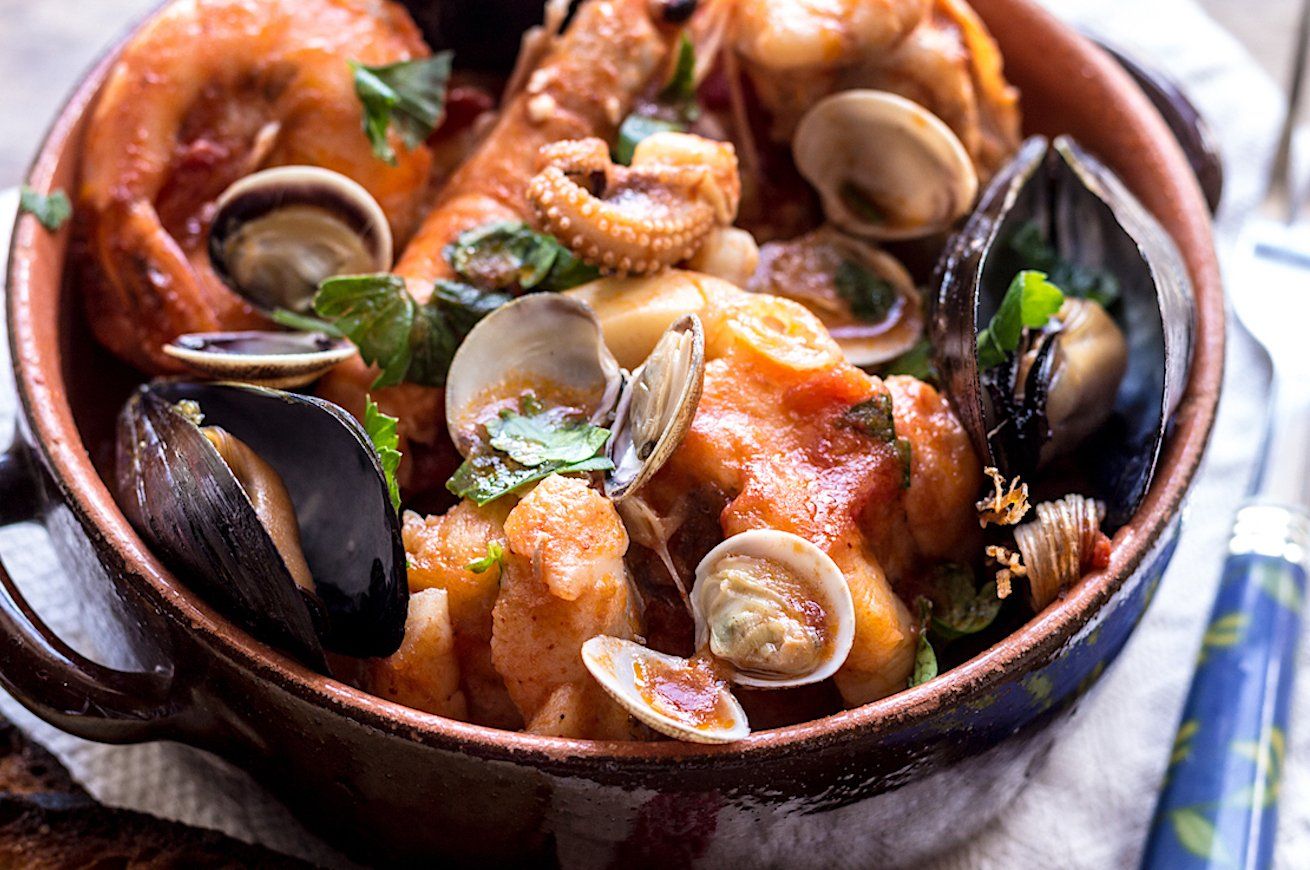
Slide title
Scrivi qui la tua didascaliaButton
-
Livorno, His Majesty the Cacciucco
Little is known about the origins of Cacciucco. Certainly this dish full of delicious flavors, of cuttlefish, octopus, scorpion fish, dogfish and other marine pleasures combined in the same pot and placed, with abundant and thick sauce, almost creamy, on a bed of toasted and garlic flavoured bread deposited on the bottom of a deep plate, due to the characteristic mix of different fish capable of coexisting harmoniously together, fully represents the “livornesità”(what it means to be “livornese”).
The origins of the recipe seem to date back to 1600, and is linked to the "Risiatori" (Wreckers), those young people who earned their living on the sea were called “risicatori”.
Were in fact called "wreckers" those young people who in the '600 earned their living on the sea; at the time there were no port rules, and the city was taking a leading role in the Mediterranean. The wreckers had every day to literally compete with each other to reach first the bulk carriers arriving at port and gain the right to unload their goods.
The wreckers were therefore on their boats waiting to leave in a frantic rowing.
In the time of waiting they stood with the fishing nets lowered into the sea to catch any fish that took the bite: squid, dogfish, conger-eel, goby, bogues, rock fish, gurnard, squill, mullet and anything else that came along. And while they were waiting for the fish, they cut pieces of bread, toasted them, rubbed garlic on them, seasoned them with oil and put them into a large pot full of a boiling mixture of freshwater and seawater. Then all the fish went into the boiling water to create a mixture of flavors separated by the slices of garlic-flavored bread. These are the origins of càciuc, it is said to be of Phoenician or Turkish origins, Küçiuk, a mixture not just of fish but also of history from which derives His Majesty the Cacciucco, the dish that makes the people of Leghorn proud of their city.
Livorno - History of Cacciucco
4/6/2025
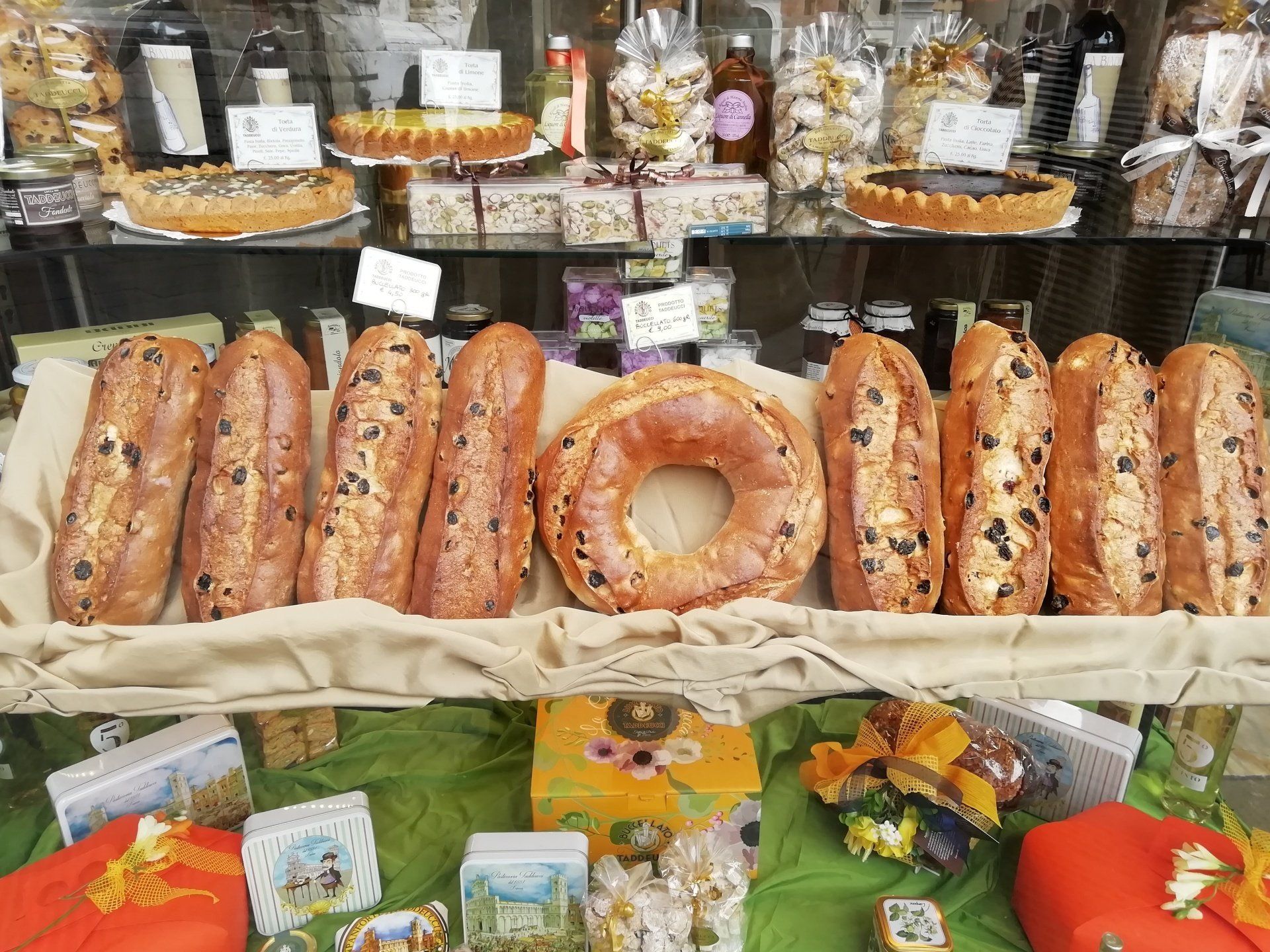
Titolo diapositiva
Scrivi qui la tua didascaliaPulsante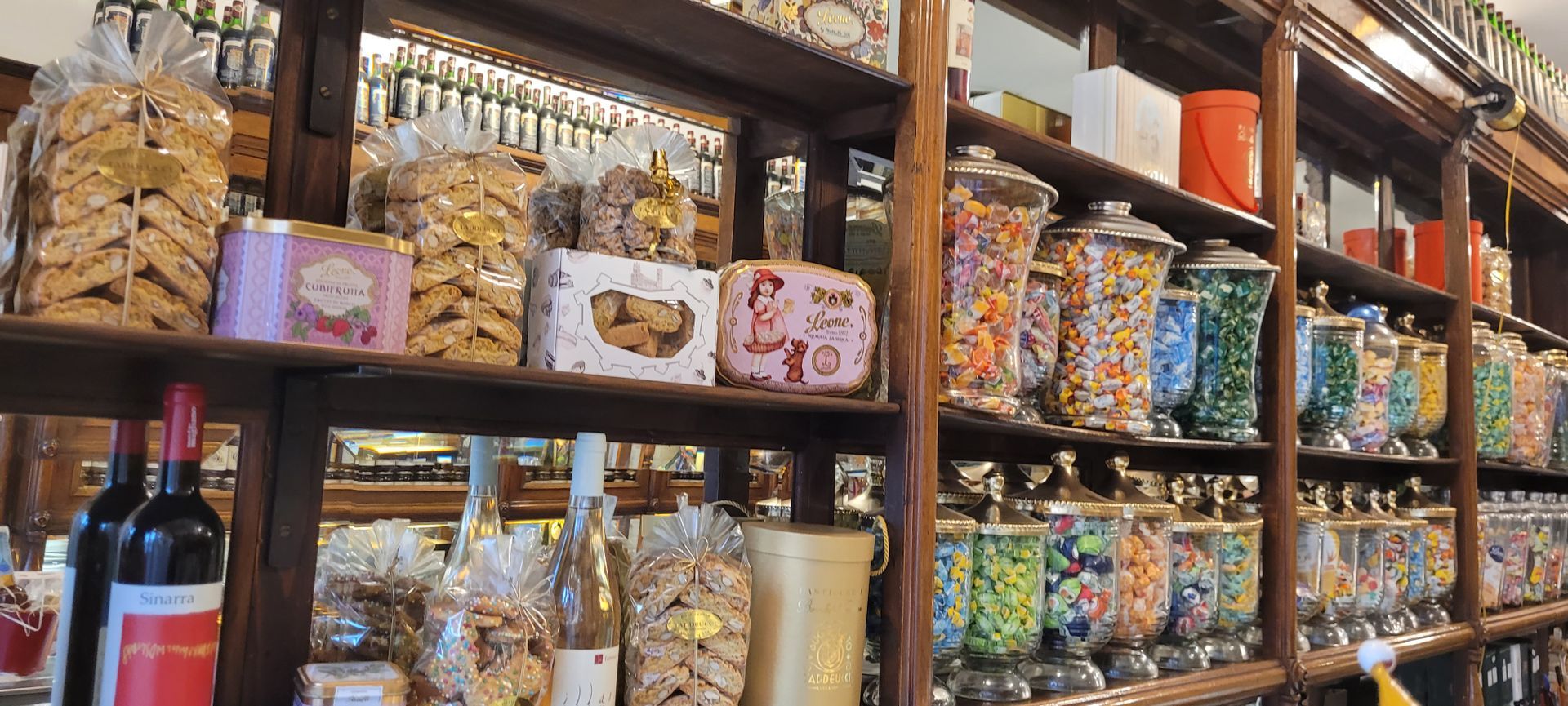
Titolo diapositiva
Scrivi qui la tua didascaliaPulsante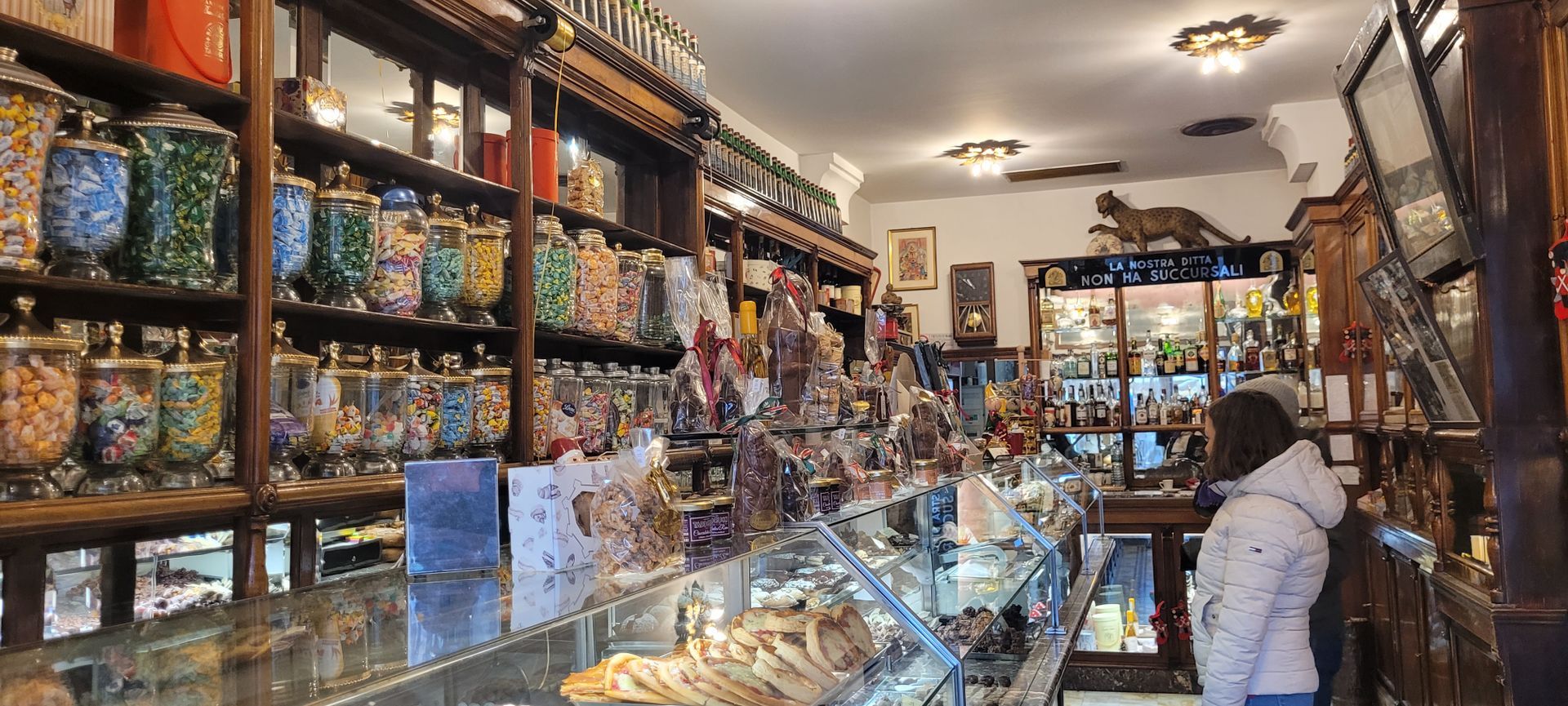
Titolo diapositiva
Scrivi qui la tua didascaliaPulsante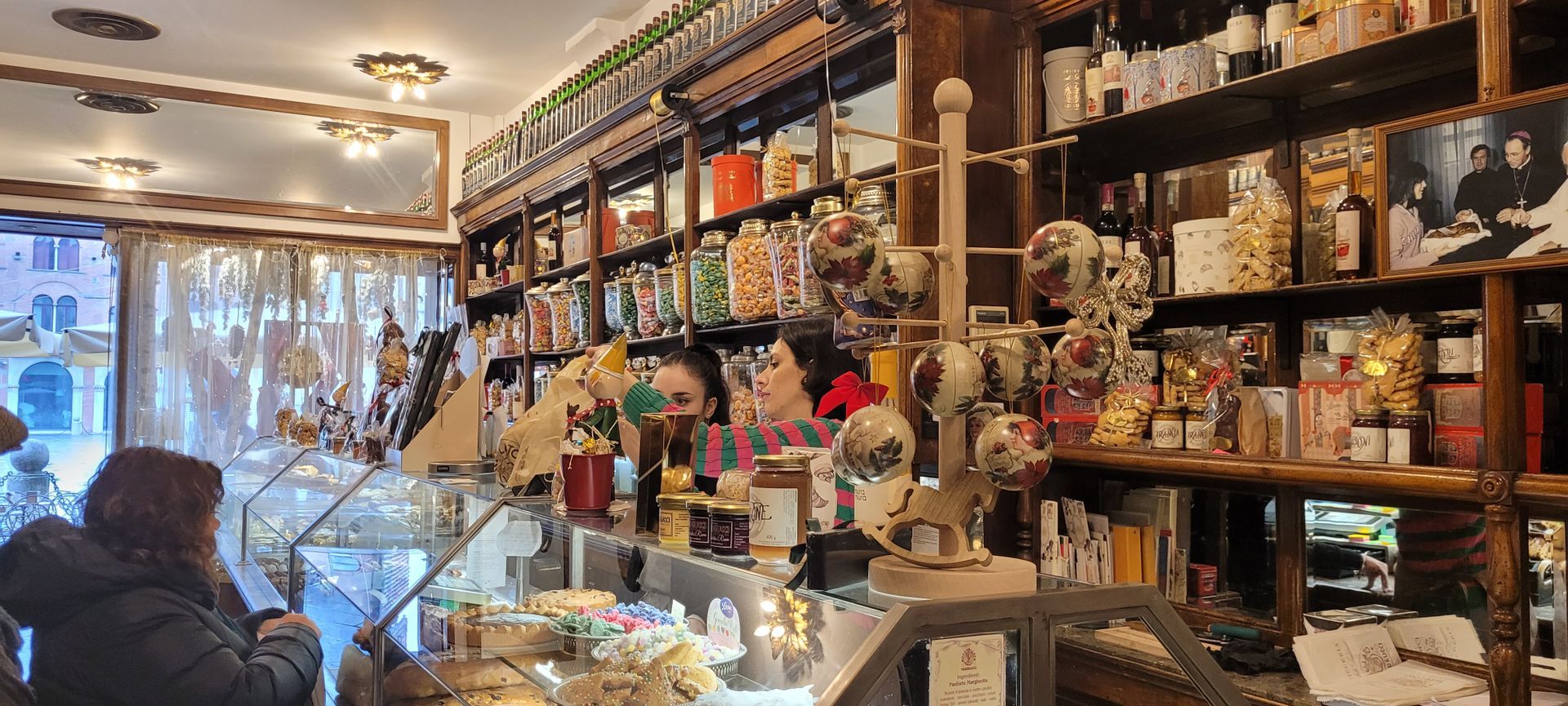
Titolo diapositiva
Scrivi qui la tua didascaliaPulsante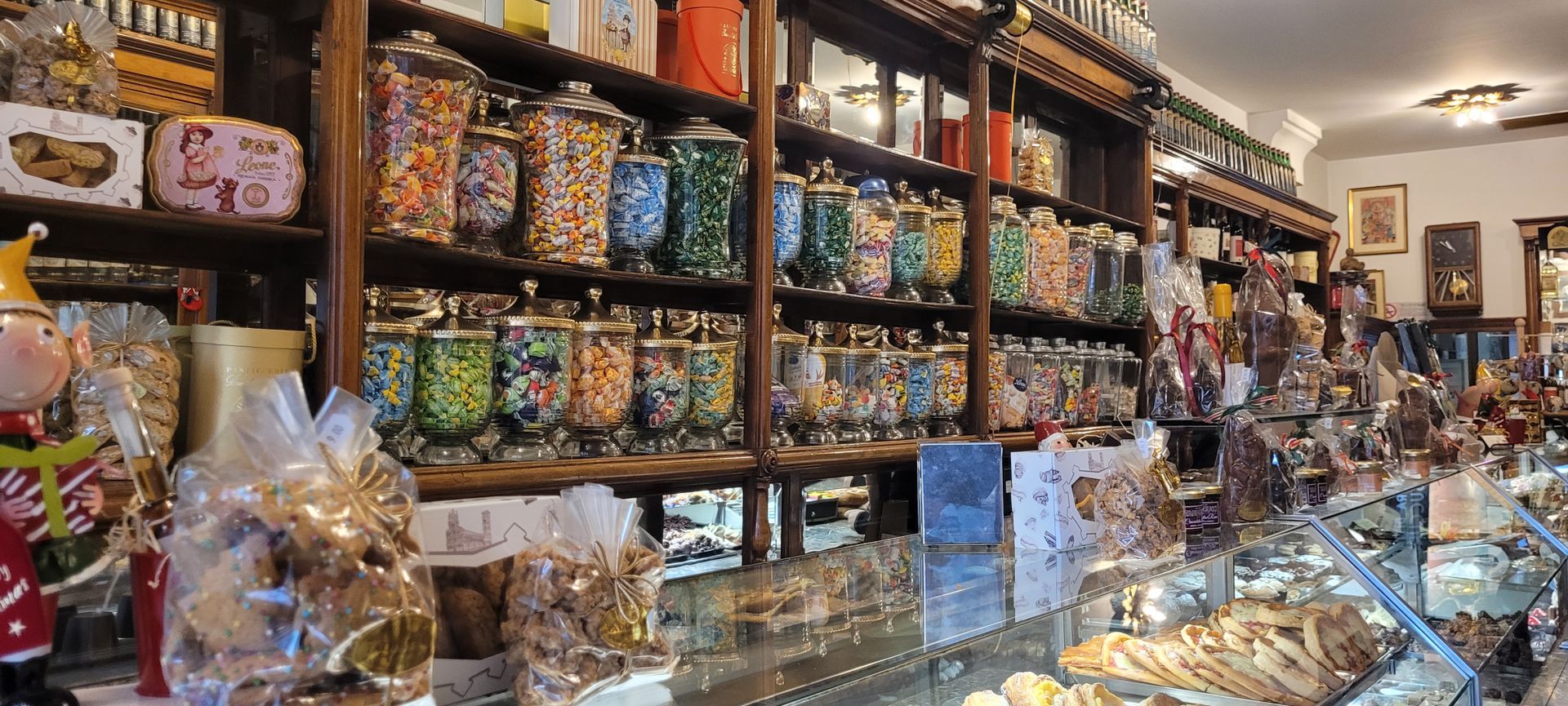
Titolo diapositiva
Scrivi qui la tua didascaliaPulsante
Titolo diapositiva
Scrivi qui la tua didascaliaPulsante
-
Lucca - The Buccellato
The Buccellato is a loaf or ring-shaped cake, whose recipe is very ancient; according to tradition, in the Middle Ages it was offered by the peasants to the lords at Christmas. It is a traditional cake, its main ingredients are: flour, sugar, aniseeds, raisins; the pastry shops of the city guard the recipe jealously. This cake is widespread in all the province of Lucca. As soon as it is purchased, it is soft and fragrant, and the Buccellato lasts for a long time. However, the buccellato is good also after some days. If it hardens, it can be eaten, soaking it in the wine, perhaps a good vinsanto from Tuscany. The People of Lucca are very proud of this cake, and there is a proverb that says: " Those who come to Lucca and do not eat the Buccellato, have never been here".
-
Where to buy it
The Buccellato is produced and sold in many bakeries in Lucca, just look for it, it is usually displayed in shop windows.
The traditional artisan pastry that has been producing Buccellato since 1881, where master pastry chefs have been following one another for 5 generations, is located right in the center of the city of Lucca, in Piazza S. Michele, and is called Taddeucci. It is easily recognizable. The shop is a splendid historical shop, with original furniture, the window is always well-kept that invites you to buy some of the sweets displayed.
Buccellato Taddeucci
Piazza S. Michele 34
55100 Lucca
Lucca- The Buccellato - Short Description and History
21/1/2025
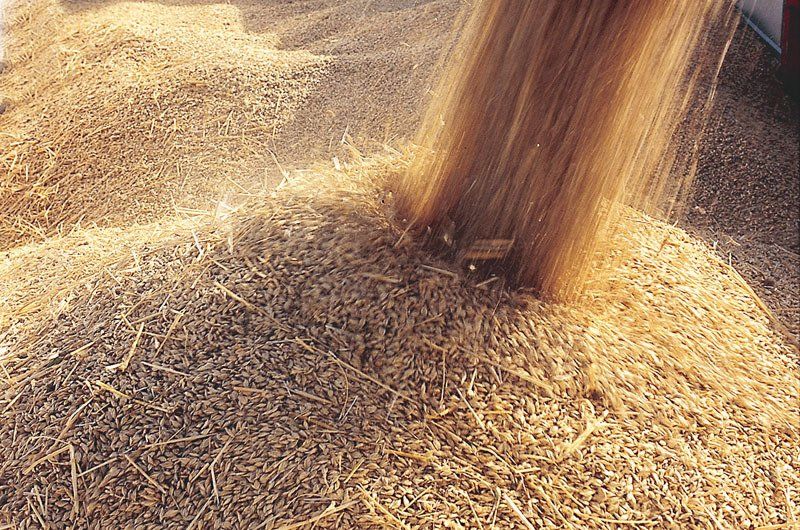
Titolo diapositiva
Scrivi qui la tua didascaliaPulsante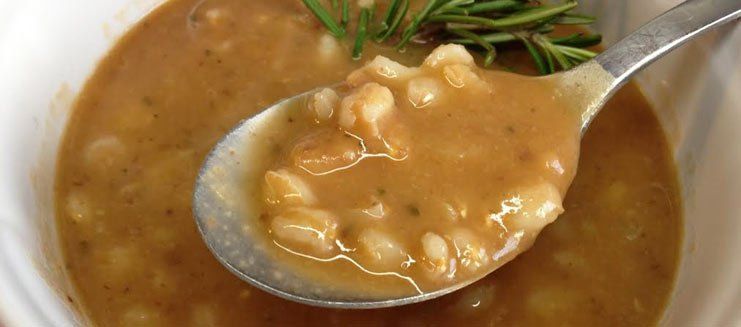
Titolo diapositiva
Scrivi qui la tua didascaliaPulsante
-
Lucca - Garfagnana Spelt
Spelt is an ancient cereal, a favourite dish of the Romans, who used it to nourish their legions.
Grown mainly in Garfagnana where it is still polished in old stone mills and regularly used to make an excellent soup and inimitable spicy cakes, in recent years it has experienced a vast rediscovery.
Thanks to the recent boom in natural and vegetarian cooking, spelt is becoming increasingly well-known outside its home region. Spelt had various uses in traditional cooking, although the best known and most interesting is as a first course. Garfagnana spelt has particular qualities which cannot be found in spelt from other areas.
Spelt soup, a typical Garfagnana dish, is not only delicious but especially beneficial for the human body.
The Garfagnana Mountain Community has obtained the IGP qualification (Protected Geographical Indication) and formed at its centre a control and promotional committee.
-
Lucca - Spelt Soup - Recipe
Ingredients for 4 people:
200 gr of Garfagnana Spelt
1/2 kg of borlotti beans
1 stick of celery
1 onion
1 carrot
3 tablespoons of tomato sauce
vegetable broth
rosemary, sage, garlic and pepper
extra virgin olive oil
Put the beans in a saucepan (previously soaked overnight) and cook them in 1 liter of water until softened. Pass half of the beans. Fry the chopped celery, onion, garlic, carrot in a pan with 4 tablespoons of oil. Add the 3 tablespoons of tomato puree, the whole beans and the pureed ones, add some broth if necessary and cook for 10 minutes. Meanwhile, boil the spelt in water for 10 minutes, then drain and add it to the beans. Finish cooking the spelt, add the finely chopped rosemary and sage, season with salt and pepper to taste.
Serve hot with und C of extra virgin olive oil.
Garfagnana Spelt - Short description and history - Recipe of Spelt Soup
28/1/2025
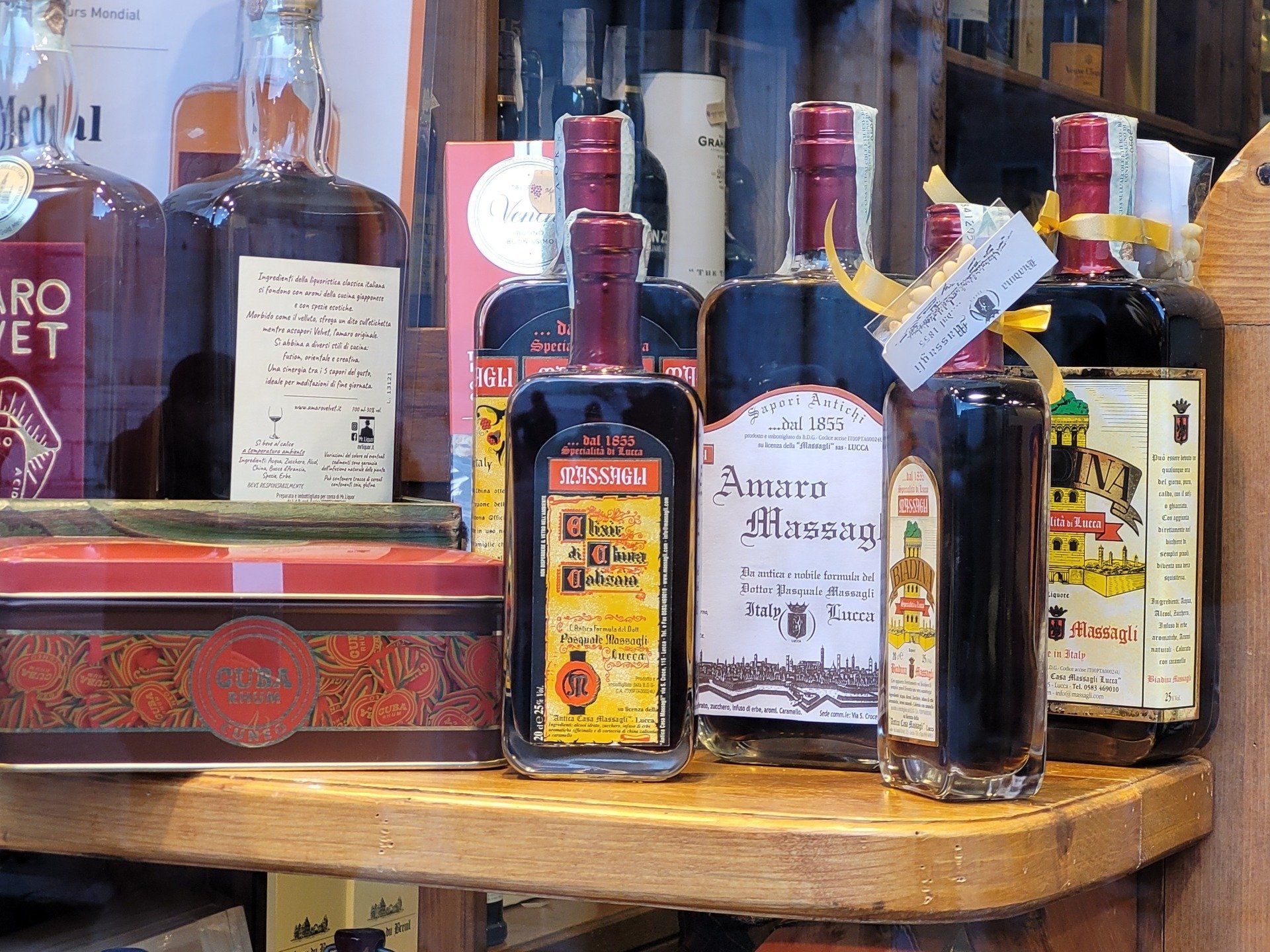
Titolo diapositiva
Scrivi qui la tua didascaliaPulsante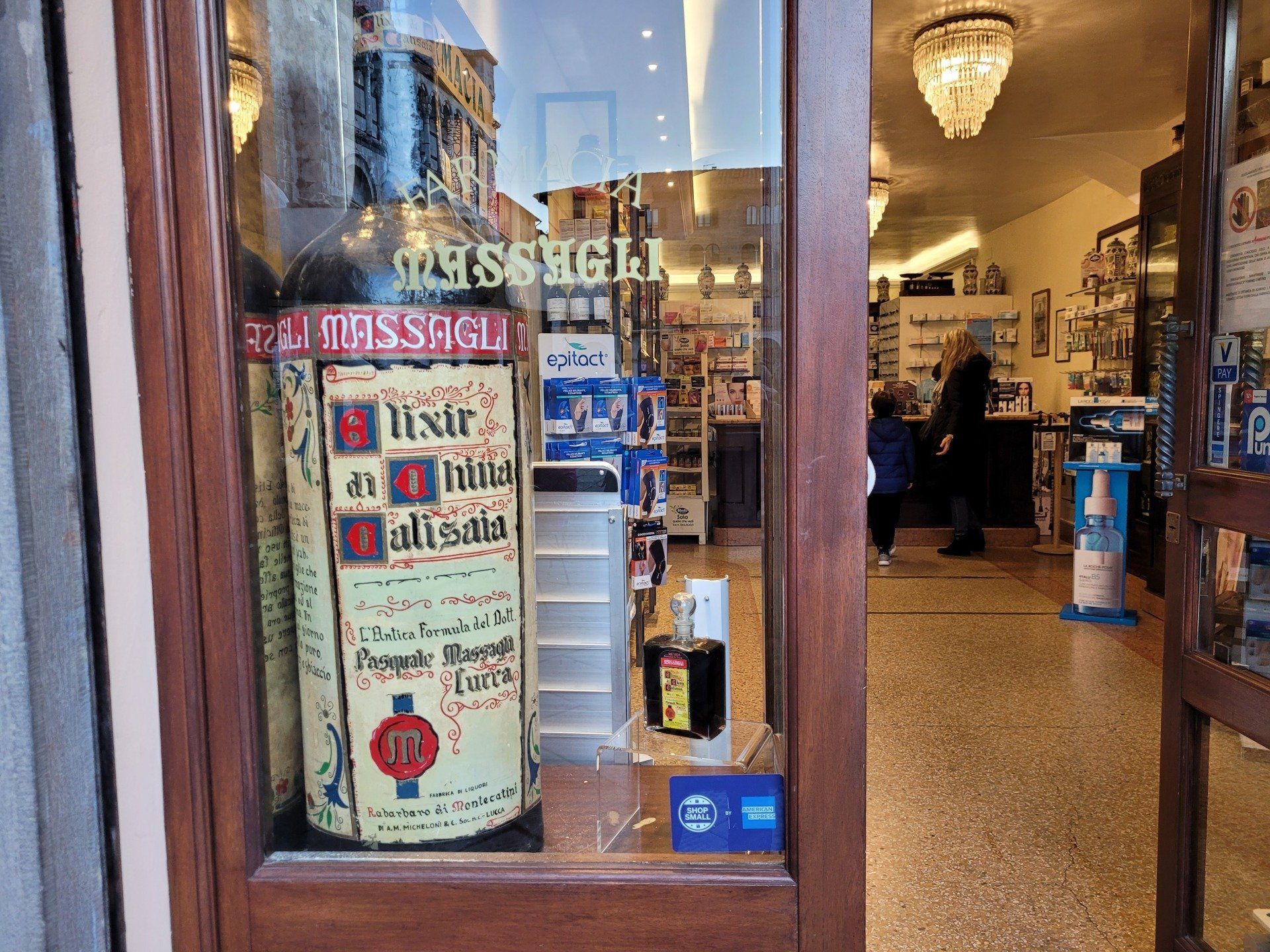
Titolo diapositiva
Scrivi qui la tua didascaliaPulsante
Titolo diapositiva
Scrivi qui la tua didascaliaPulsante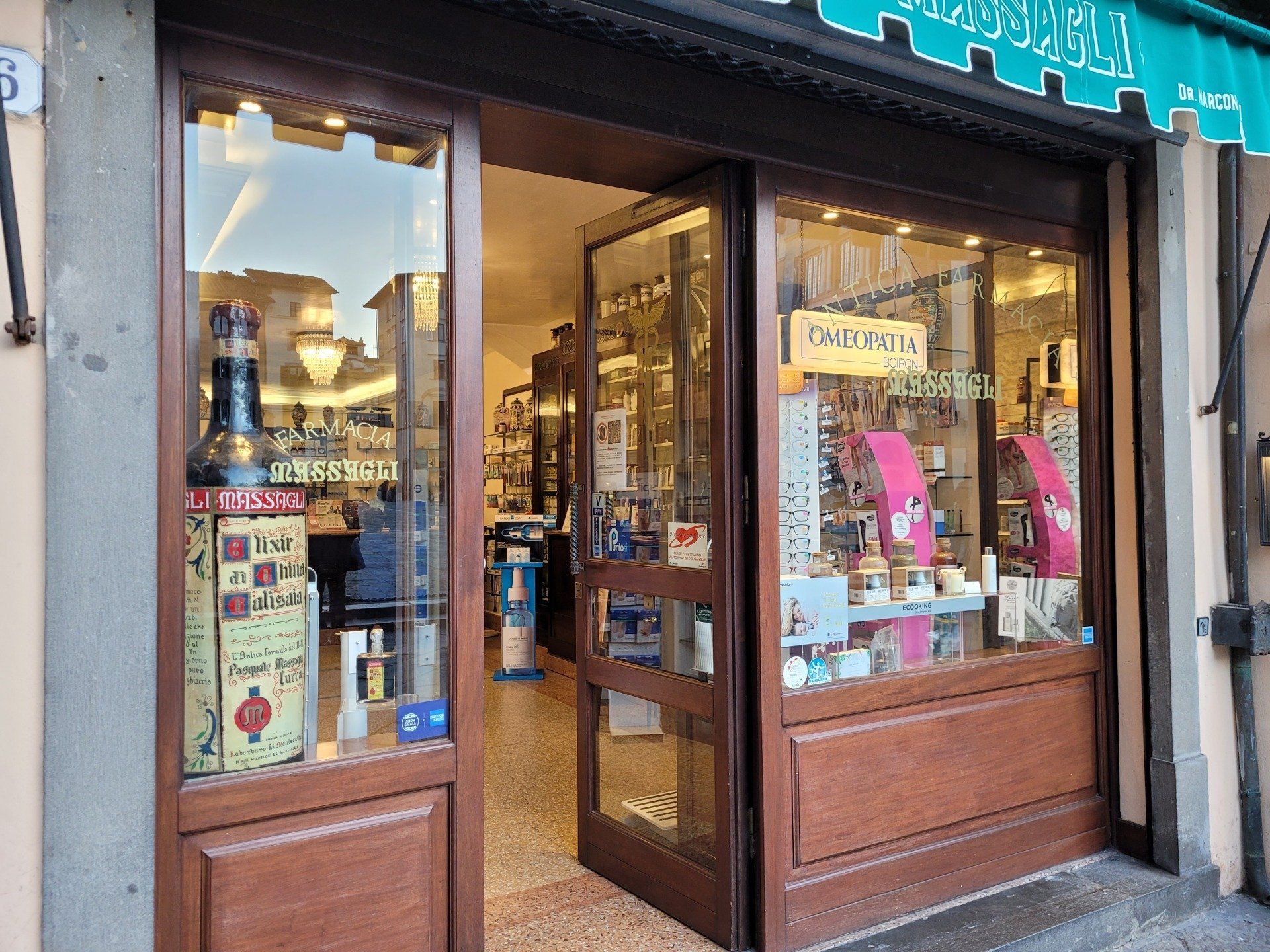
Titolo diapositiva
Scrivi qui la tua didascaliaPulsante
-
Lucca - Massagli Elixir of China
In 1855 Dr.Pasquale Massagli created the Elixir of China in the old pharmacy still present in Piazza San Michele, Lucca, to treat a malaria epidemic that had spread to the city in the mid-nineteenth century. After healing thousands of people and saving many lives, this Elixir changed its use and became an excellent energetic and digestive liqueur.
The liqueur is produced using an antique formula where the bark of the Chincona Officinalis tree - an Andean plant from which quinine is also obtained - undergoes a lengthy maceration with the additon of some aromatic herbs and spices such as cinnamon, nutmeg and cloves. It is a dark amber-colored liqueur with a delicately bitter herbal taste.
Having no artificial preservatives or colourings the product preserves the original properties and natural aroma.
-
Where to buy it
Massagli Elixir of China, Lucca - Short description and history
22/1/25
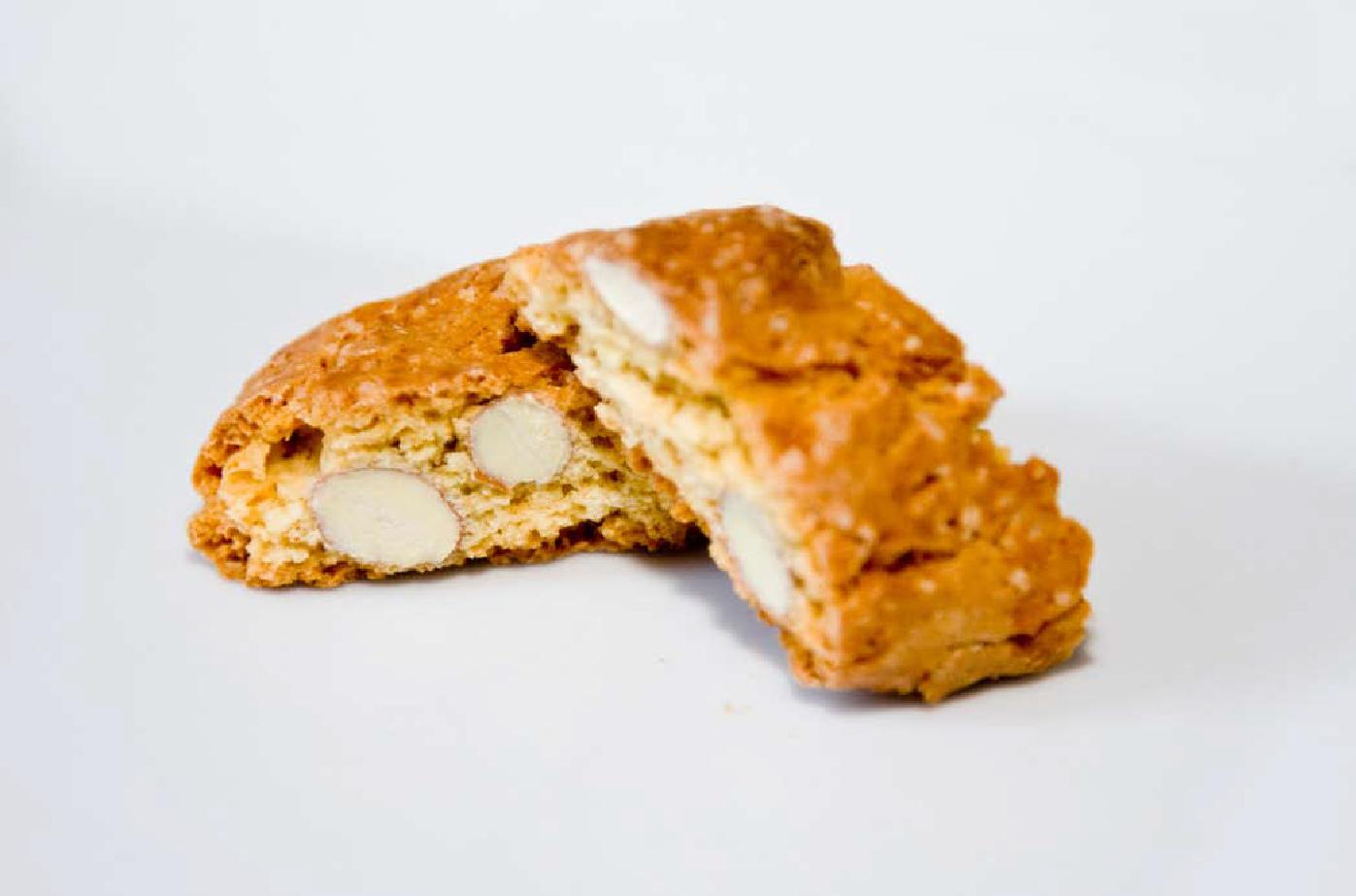
Titolo diapositiva
Scrivi qui la tua didascaliaPulsante
-
Prato - The Cantuccini
To talk about Prato and not talk about them is impossible… They are the famous biscotti said to be from Prato, but also called “cantucci” or “cantuccini”. They are one of the culinary delicacies of Italy and a feather in the hat of Tuscany.
Their origins, besides the legend that does nothing but increase the myth, it is known for certain that, the first documented recipe for this sweet is found in a manuscript conserved in the Prato archives, written down by Amadio Baldanzi, a learned resident of Prato from the XVIII century, and in this document the cookies are called “genovese” (from Genoa). This recipe was used again by the pastry maker, Antonio Mattei in the XIX century and since then has remained that which, becoming the definitive traditional recipe, distinguishes the original cookies from Prato from the numerous modern imitations. The Prato biscotti obtained great success in 1867 during the course of the World’s Fair that earned Mattei a special mention. Since then, the boom… To this day the best cookies are those baked in the well-frequented Biscottificio where the descendents of Antonio Mattei work, ready to give you a package of cookies in their typical blue waxed paper: the famous mattonella …
The dough is made exclusively of flour, sugar, eggs, almonds and pine nuts. The almonds are neither toasted nor skinned. No leavening or fat is used. As accompaniment it is a must to have an excellent bottle of Tuscan Vin Santo. But remaining in the halo of the myth, let’s return to the name and to why in the beginning we wrote that they are also improperly called “cantucci” or “cantuccini”. The true name should be “Biscotti di Prato” because at one time, cantucci were large rustic cookies made of bread dough enriched with olive oil and anise seeds. The double sense of the name may come from the fact that on the old Biscottificio Mattei sign (still present today), under the name of the store is written: “Fabbricante di cantucci” (maker of cantucci), which at that time was one of the main products of the cookie shop. Then, while the Biscotti di Prato went on to acquire fame, the cantucci became a minor product and almost forgotten, but the sign has remained there, unchanged… Probably then, people came to associate the name “cantucci” with the new cookies.
-
Cantuccini Recipe
Ingredients
500 g. flour
250 g. sugar
50 g. bain-marie melted butter
250 g. sweet almonds
6 eggs (one of which t0 brush (on before baking)
half a sachet of yeast and lemon rind as needed
1 Small Glass Vinsanto
On the baking-board make a volcano shaped mound with the flowr, sugar, 3 whole eggs and two yolks, lemon rind and yeast, und knead by hand adding butter and the Vinsanto. The dough should be soft; add the almonds previously toasted in the oven for 3 minutes and knead it a bit more. Divide the dough into small loaves the length of the baking dish. Before placing them in the hot oven, brush them with the eggyolk, then bake at 180° for about 30 minutes.
Afier baking, cut the loaves obliquely to give the biscotti their characteristic shape, then return t0 the oven for 5 minutes t0 finish baking. Serve with Vinsanto. There is a dispute among gourmets: one party asserts that for best results biscotti should be dipped in the Vinsanto tumler, the other claims that they should be eaten natural and the Vinsanto sipped separately.
-
Where to buy them
The Cantucci are sold in many bakeries and Tuscan specialty shops.
For those wishing to buy cantucci from the best known producer this is the address:
Biscottificio Antonio Mattei
Via Ricasoli 20
59100 Prato
The Cantucci of Prato - Short description and history
23/1/2025
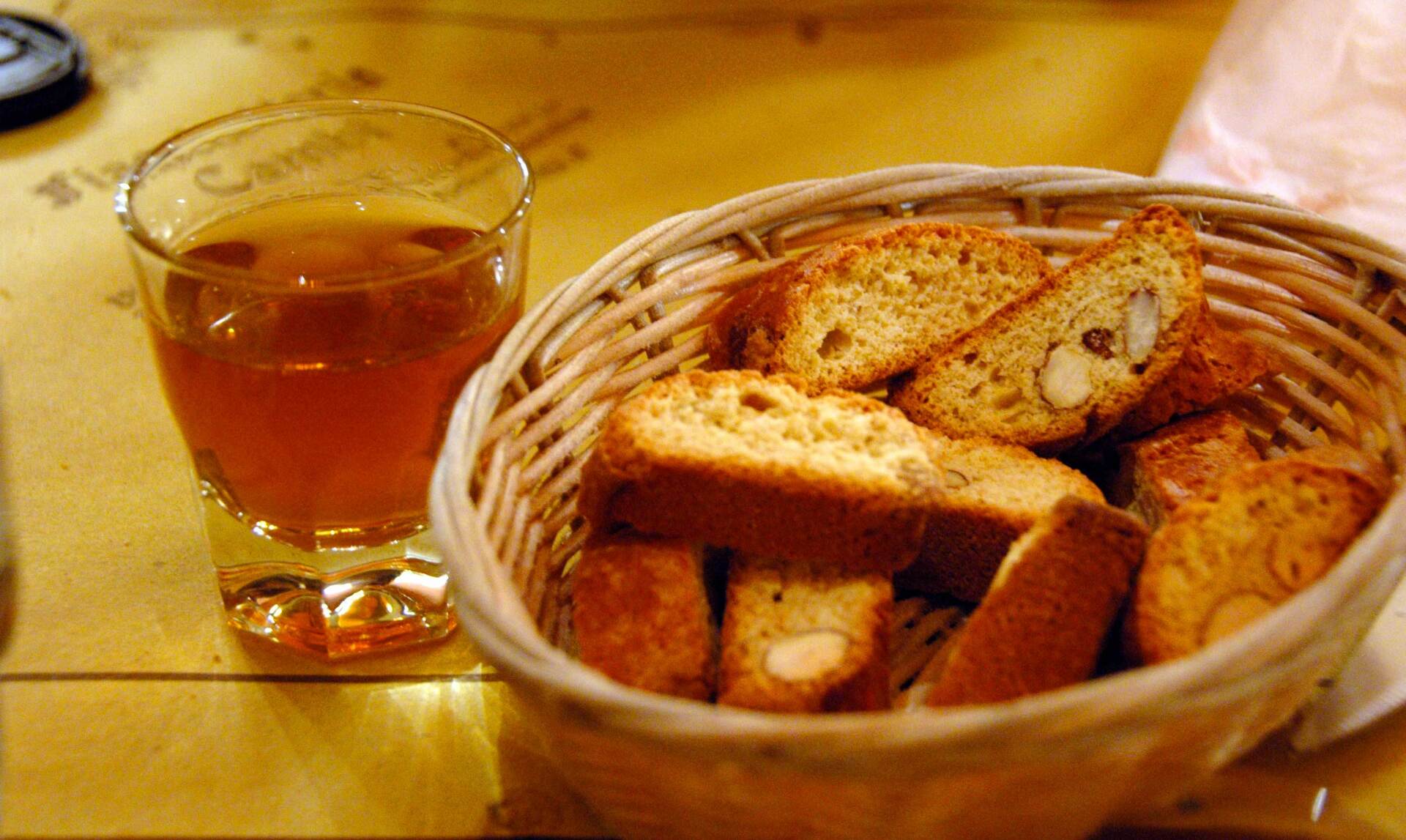
Titolo diapositiva
Scrivi qui la tua didascaliaPulsante
-
The Vinsanto
Vin Santo is perhaps the wine that in the collective imagination is most linked to Tuscany.
Nectar with a noble and peasant soul, has legendary origins. The first citations date back to the beginnings of Christianity, perhaps to indicate a pure wine particularly suitable for the rite of Mass.
Later, it is said that in 1348, during the plague that broke out in the Sienese area, the dying who ingested the mass wine given by a friar seemes to have exclaimed "vinsanto" for the sensations of relief they experienced.
Another interpretation traces the birth of the term back to 1439, the date of the Council called by Pope Eugene IV to discuss the union of the Western Church with the Eastern one. There were seven hundred high Greek prelates, and among them the humanist Cardinal Bessarione, bishop of Nicaea, who while tasting sweet Tuscan wine seems to have exclaimed: "But this is Xantos!" (wine produced on the Greek island of Xantos), later transformed by those present into the Latin adjective "santus".
A final explanation refers instead to the production cycle of vinsanto, based around the most important religious holidays of the Christian liturgical calendar. Some squeeze grapes for All Saints, others for Christmas and others for Easter. Some bottle Vinsanto in November, while others in April.
Vinsanto has always been a non-commercial product: it was the welcome wine, produced in minimal quantities and given to guests of considerable importance. The major vinsantaie were housed in the farms and in the city palaces, but even the smallest farmers produced it.
Made with Trebbiano and Malvasia grapes, it retains the charm of a process remained almost unchanged over time, gathering the best bunches (harvest "by choice") to dry them by laying them on wattle mats or hanging them on hooks. After drying, the grapes are pressed and the must (with or without pomace depending on the tradition) is transferred into chestnut and oak barrels of variable size (generally between 15 and 50 liters) from which the vinsanto of the previous production has just been taken off, using the lees of the past production as an important component for the success of the vinsanto itself, so much so that it is called the mother of vinsanto.
The kegs are then sealed and placed under the roof of the main villa or of the country house, as it is believed that the strong summer-winter temperature variations are beneficial to fermentation and / or to the scents of the wine. It is generally believed that three years of fermentation / aging are sufficient for the production of a good vinsanto even if some producers age it for more than ten years. Generally only twenty-five liters of vinsanto are obtained from a quintal of fresh grapes.
Golden to amber in color, with an intense, ethereal aroma, with hints of honey, walnuts and raisins, it can be dry or more distinctly rounded and sweet.
Vinsanto - Short history
24/1/2025
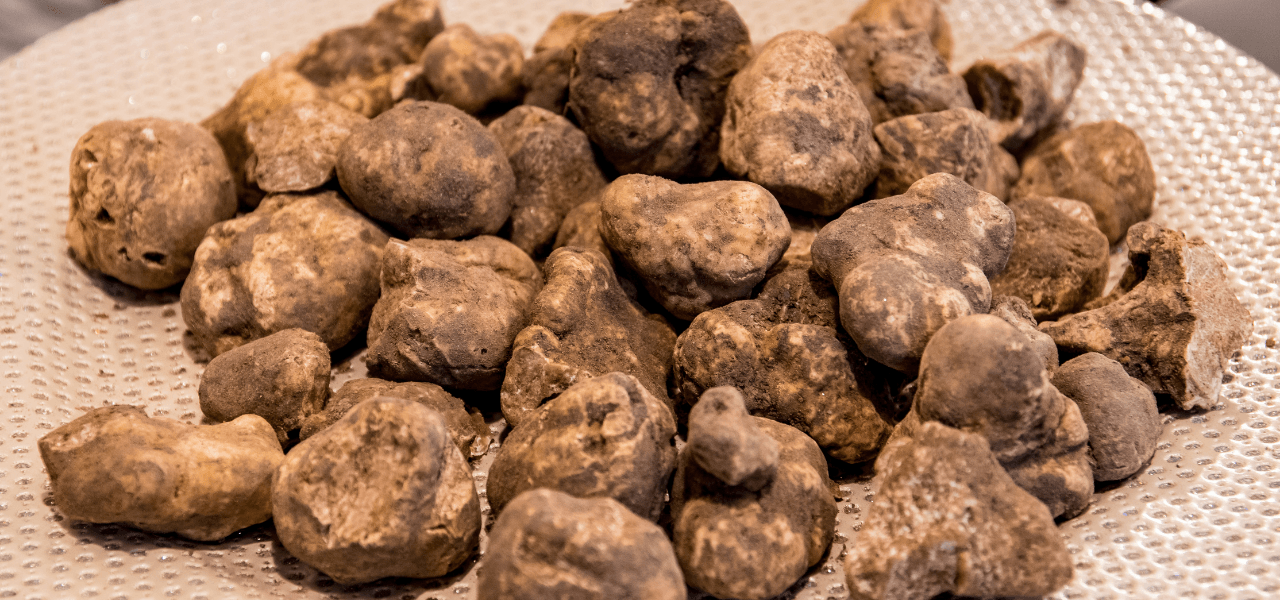
Slide title
Scrivi qui la tua didascaliaButton
-
The Truffle of S. Miniato
In the immaculate rustic hinterland, oaks, lime trees and willows host between their roots the finest mushrooms can be found: it is the white truffle of the San Miniato hills. The Tuber Magnatum Pico, this is its scientific name, is always a source of wealth of our lands. For over a century San Miniato truffles go out during the night with their dogs and walk through hidden paths between the trees, trying to capture the minimum and weakest trace, so they can excavate and collect the precious tuber.
It is right in San Miniato that every year in November, the National White Truffle of San Miniato Festival takes place, which is a great showcase/market that attracts thousands of Italian and foreign visitors.
The S. Miniato truffle - Brief history and characteristics
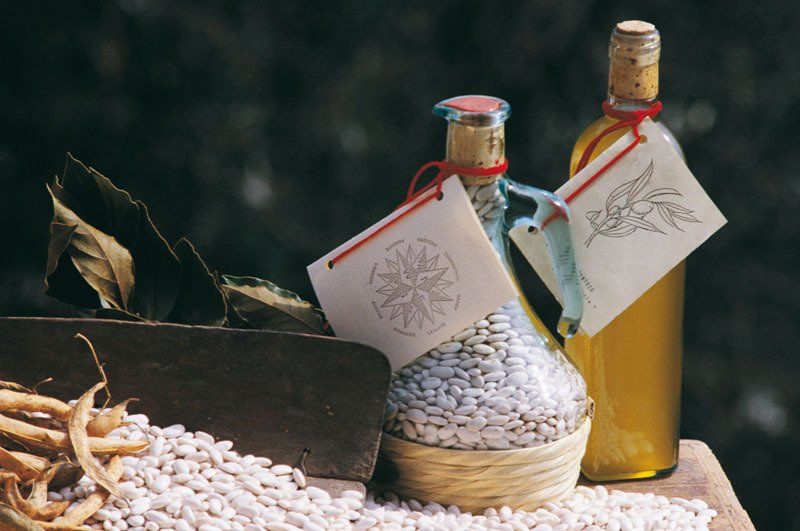
Titolo diapositiva
Scrivi qui la tua didascaliaPulsante
-
Sorana IGP Beans
The ancient Fortress of Sorana (one of the 10 Castella of the little Switzerland of Pescia) dominates with its strategic position that leads into the valleys formed by the two branches of the Pescia River. Famous for its iron foundries and paper mills, it played a key role as a rest station during the times when the hillside villages were connected only by steep, almost impassable mule-tracks. Today, its name is associated with one of the most exquisite products of local gastronomy: the famous Sorana IGP bean, cultivated on the dry bed of the Pescia torrent and renowned worldwide for the unparalleled taste and the delicacy of its skin (many people, in fact, call it “the bean without skin”): once boiled, pulp and skin become as one and the latter can hardly be tasted. I strongly suggest you try some with extra-virgin olive oil dressing, you’ll certainly lick your chops and...mop up the dressing on your plate with bread, just like we Italians usually do.
The distinctiveness of this legume is in fact unique and not repeatable. Sorana beans are a type of leguminous climber that belongs to the botanical species Phaseolus vulgaris L.
A bean plant often exceeds four meters in height. With its typical lance-shaped leaves, it twists from left to right along the supports planted in the ground. The seed may be a milky white with modest pearly veins, while the heritage Sorana red bean is reddish with darker streaks.
These small, irregularly shaped, flat white beans, (hence their nickname of piattelino, very small plate) differ greatly from cannellini beans. The red beans are larger and cylindrical but what most distinguishes them is their taste. Tender and delicate, they have a smooth, thin skin that, after proper cooking, becomes imperceptible and blends completely with the pulp, making them a particularly sophisticated food. In addition to their organoleptic properties, they are easy to digest and therefore recommended by dieticians and nutritionists.
Like all legumes, they have a high energy value, considerable protein content, and a moderate mineral salt content. In addition, they do not lose their nutritional value during cooking.
If you would like to taste the exquisite and genuine local cuisine, the realm of the delicate crock-baked Sorana IGP beans is the Trattoria da Sandrino in Sorana.
The Sorana IGP Bean - Short history and where to taste it
14/2/2025
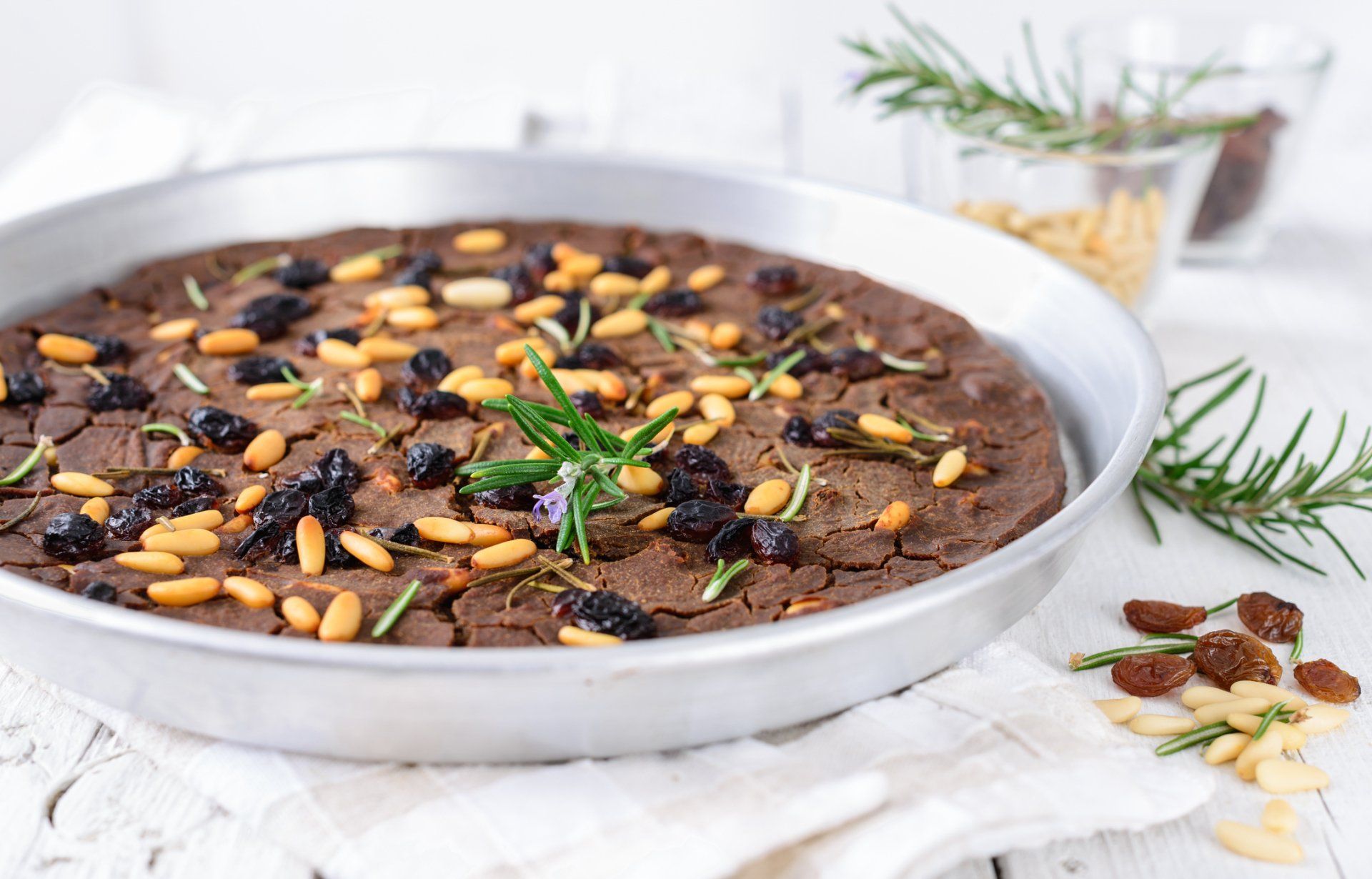
Titolo diapositiva
Scrivi qui la tua didascaliaPulsante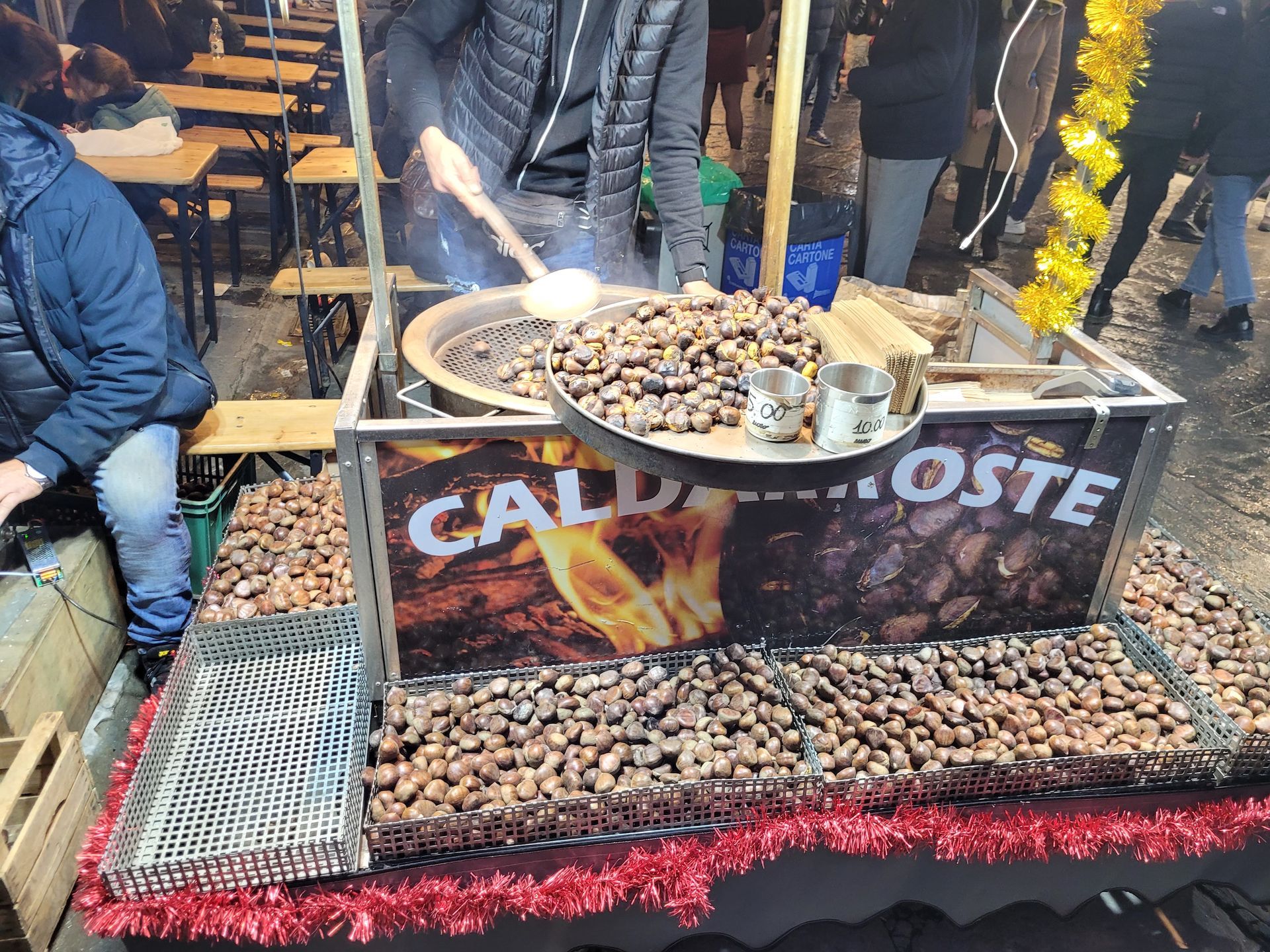
Titolo diapositiva
Scrivi qui la tua didascaliaPulsante
-
The “bread tree” (chestnut tree)
The chestnut tree has been, for several generations, the main source of livelihood of the foothills areas. The products deriving from chestnuts, first of all the flour, are still today the flagship of the local production, and have important recognitions as Protected Designation of Origin (P.D.O.).
This culture has shaped the land, has crepted rural architectural styles, has formed a craft related to the processing of its wood, has created new crafts, it was, in a word, the most important element of the life of these places, the “bread tree”, in fact.
-
Chestnut Cake - Recipe
Ingredients for four persons
400g Chestnut Flour
500g Water
30g pine nuts
50g of raisins
Rosemary, oil, salt
Add to the flour a little at a time the water and a pinch of salt. Amalgamate and pour into a round pan previously greased with a little oil, in a layer 1.5 cm high, sprinkle the surface with a little bit of oil, the pine nuts, the pieces of rosemary, and the raisins. Bake for 40 minutes at 180 °.
The Chestnut tree and its flour. Short history and Recipe of chestnut cake
1/2/2025
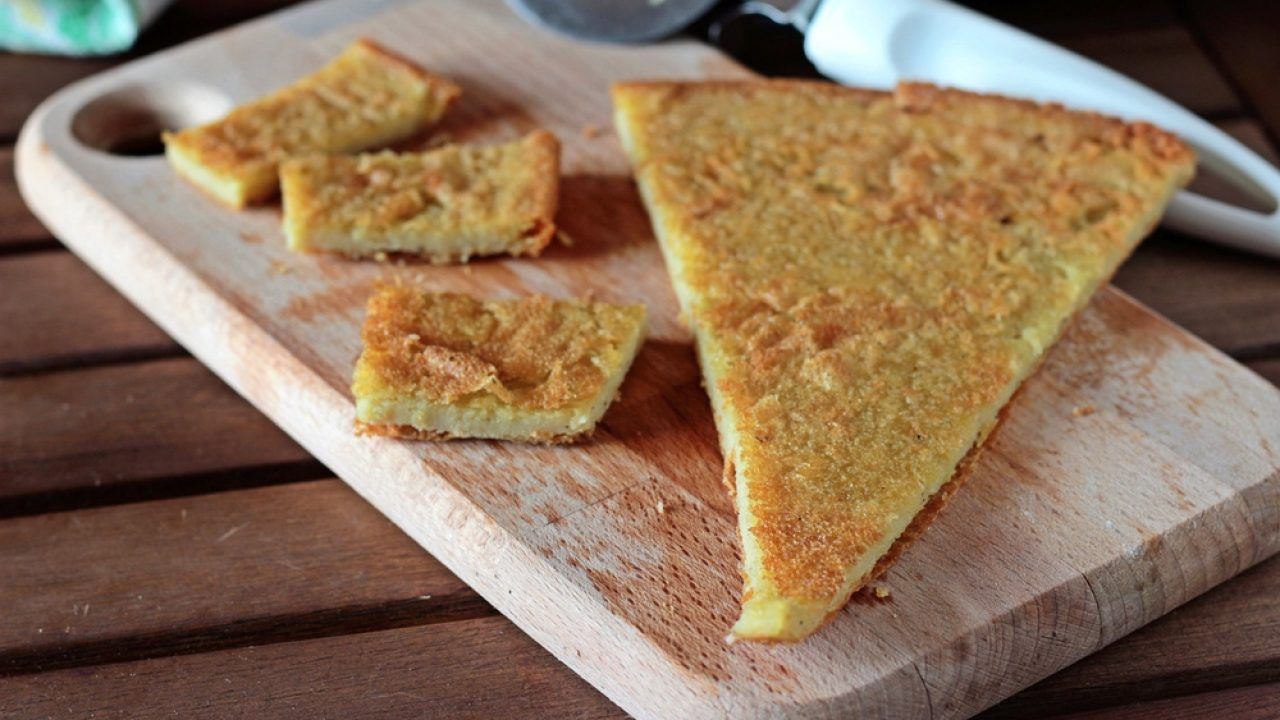
Titolo diapositiva
Scrivi qui la tua didascaliaPulsante
-
Pisa - Chickpea flat bread
It is said that after the battle of Meloria (1284), during the journey that brought the Pisan prisoners to Genoa, a strong storm caused the breaking of some oil barrels and crates of chickpea flour. The golden powder thus blended with oil and sea water and, thanks to the heat of the August sun this fragrant puree dried and transformed into the so-called "Pisan gold’.
Prepared in large copper pans and served with a sprinkling of salt and pepper the cecina is present in almost all the pizzerias in the city of Pisa and of the neighboring municipalities.
It can be tasted inside a stiacciatina, a typical focaccia, but it is also delicious as a filling for a piece of "pizza alla pisana", with tomato, parmesan, capers and anchovies, traditionally accompanied by a glass of “blonde foam".
-
Recipe of Chickpea flat bread
Ingredients
200 gr of chickpea flour
600 gr of water
6 tablespoons of extra virgin olive oil
1 teaspoon of salt
pepper as needed
rosemary
Place the chickpea flour and salt in a bowl, mix with a whisk and start pouring the water a little at a time until all lumps are eliminated.
Add three tablespoons of oil and mix again. Cover the bowl and let the mixture rest for at least three hours.
Turn on the oven to 250 ° C and when it reaches temperature uniformly oil a 32 cm diameter pan with three tablespoons of oil.
Pour the batter into the pan add the needles of a sprig of rosemary and bake. Cook for 25-30 minutes or until the cecina is golden and a nice crust has formed. Serve hot with a sprinkling of pepper to taste.
Chickpea flat bread - History and recipe
20/7/2025
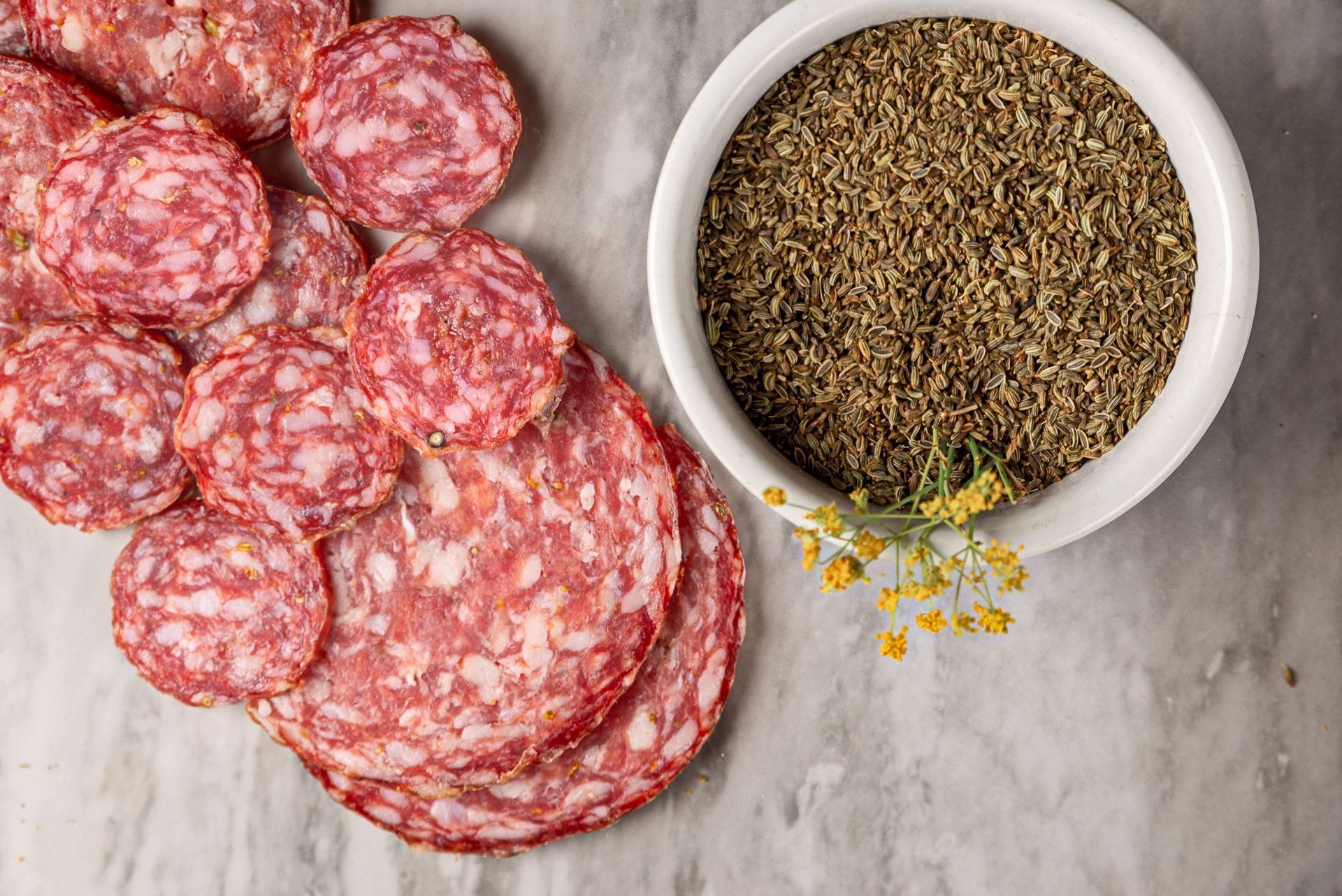
Titolo diapositiva
Scrivi qui la tua didascaliaPulsante
-
Finocchiona
This is certainly the most famous cured meat product in the whole of Tuscany, made in the Chianti area. Experts in the sector assert that it was invented in the area between Greve in Chianti and Impruneta, at the time in which fennel seeds were used to preserve meats, because pepper was rare and expensive... This salami can be instantly recognized by its large dimensions, its pinkish meat and large white pieces of fat. It is made from a blend of pretty large chunks of lean meat and pork fat minced together. In certain areas of the Tuscan countryside, there is a variant known as "sbriciolona". The mixture is the same, as is the seasoning (salt, pepper, garlic and wild fennel seeds), but the mincing process is different. In fact, the meat mixture is hand chopped using a knife, by the salami maker who prepares the "sbriciolona". This results in a more crumbly mixture, which crumbles (sbriciola) pleasantly when it is sliced: hence its name!
There is a legend surrounding the name of this product which says that the term "infinocchiare" (to bamboozle) derives from finocchiona. The peasants pinned this term on those who purchased wine by the litre. The spices that were added to the wine had an anaesthetic effect on the taste buds of these innocents, making even poor quality wine seem good to them. Hence the Tuscan term "infinocchiare", which means to bamboozle or hoodwink.
La Finocchiona
13/7/2025
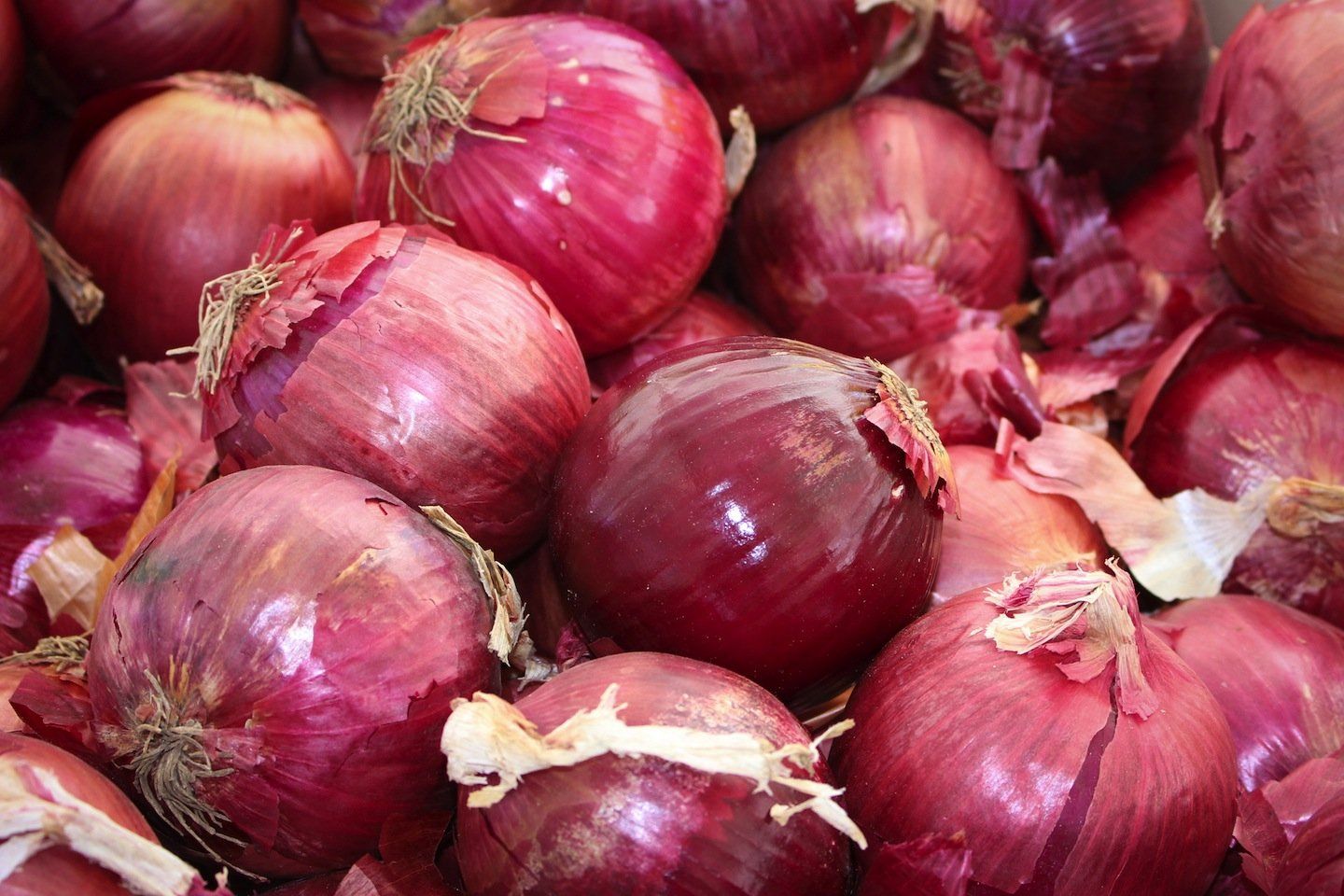
Titolo diapositiva
Scrivi qui la tua didascaliaPulsante
-
The onion of Certaldo
Certaldo, the city of Boccaccio, is famous not only for its renowned writer but also for another exceptional protagonist: the onion. This precious vegetable is so important to the city's identity that it even appears on the municipal coat of arms, along with the motto: "By nature, I am strong and still sweet, and I please those who stay and those who work." This is not just a tribute to the onion, but also to the character of the people of Certaldo, who, like the onion, are sweet yet strong.
The fame of the Certaldo onion dates back to 1100 when the Counts Alberti, the local feudal lords, helped make it a symbol of the area. Boccaccio himself, in his Decameron, mentions the renowned Certaldo onion, which was already famous throughout Tuscany during the Middle Ages. The fertile soil surrounding Certaldo has always favored its cultivation, giving it a tender texture and a unique flavor that sets it apart from other varieties.
Today, in an era of agricultural and dietary change, the Certaldo onion has been revived thanks to the efforts of Slow Food and the Tuscany Region, which have supported its production, protecting it as one of the typical products of Tuscany's rich culinary tradition.
There are two main varieties of Certaldo onion. The Vernina, grown in winter, is distinguished by its deep red color and flattened shape, with a strong, pungent flavor. The Statina, on the other hand, is grown in summer, with a more rounded shape, a violet hue, and a milder taste, ideal for eating raw.
The Certaldo onion is an incredibly versatile ingredient in the kitchen, used in everything from appetizers to desserts. Among the traditional dishes where it shines are "francesina" (stewed beef leftovers), soups, and the delicious onion cream. The cream is made by gently sautéing onions in hot oil, adding a bit of vegetable broth and potatoes, then serving it with Tuscan bread croutons. The result is a delicate yet flavorful dish that represents the authenticity of Tuscan cuisine.
More than just a unique gastronomic resource, the Certaldo onion represents a deep connection to the land and its farming traditions, making it not only an agricultural product but also a symbol of local culture.
Certaldo, brief history and what to see
19/10/2025
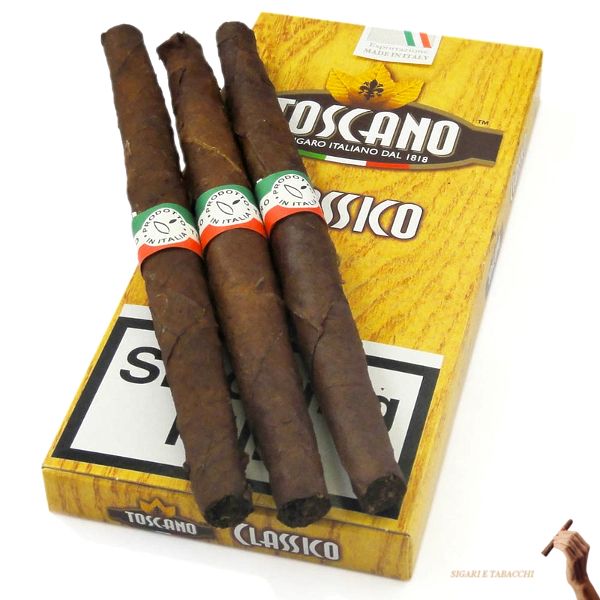
Titolo diapositiva
Scrivi qui la tua didascaliaPulsante
-
The "Toscano" Cigar
The history of the “Toscano” Cigar is by now legend: Florence, August 1818, in the Tobacco Factory belonging to the Grand Duke of Tuscany, Ferdinand III, a shower caught the Kentucky tobacco which had been drying outside by surprise. Instead of throwing it away it was chosen to be used for making inexpensive cigars for the common people. But what was considered to be a way of recovering an economic plight, was transformed into a huge success. The wet tobacco had fermented thereby giving the cigar a new taste which appealed to the people. From that moment on the Tuscan cigar would be produced in Florence for the next 130 years; after the war production was moved to the Tobacco Factory in Lucca and Cava dei Tirreni. Today it is produced in Italy by the Manifatture Sigaro Toscano S.p.A.
Made by women but appreciated by men, its secret lies in the production process. With the passing of centuries, the craft has not changed: still to this day, no machines are used and the job is done by the tobacco ladies and their gentle hands. The best among them are able to make 500 cigars in one day. They dip their fingers into a bowl full of cornstarch glue.
This natural adhesive spread on the little wooden board, keeps half of a Kentucky leaf well-adhered to the board. They smooth the tobacco, measure the right quantity, length and size, and create a cigar, rolling the wrapper so that it will not open during drying. Excellent manual dexterity, precision and passion, these are the three essential requirements of a cigar maker, a craft that was carefully handed down from mother to daughter. Today, a 18-month apprenticeship - under the strict supervision of an expert
teacher - is needed to learn these ancient skills. In the mid-19th century there were only 20 of them; by the eve of World War One their number had risen to 1500. Last century's female cigar makers were the first mass of workers who fought for women's rights in Italy and achieved the goal of workplace nurseries. That had never happened before in Europe.
The Tuscan cigar has the characteristic form of ‘blunt’ extremities with a diameter inferior to that of the central part. Length varies from a minimum of 15.5 cm. to a maximum of 16.3 cm. the sole exception being “Il Moro” which is 23 cm. long. The key to the manufacturing process, which has remained substantially the same over the last 200 years, lies in the fermentation. The Kentucky tobacco on arrival at the Manifattura, is selected, placed inside huge crates and immersed into tanks of demineralised water. When the temperature reaches 50/60°, in order to avoid possible rotting, it is cooled and aerated. Once the central vein of the leaf has been eliminated, the leaf is then placed in crates, called “marnoni”, and fermentation begins. The tobacco to be used for filling is crushed or cut according to the type of cigar. At this point the Tuscan cigar is prepared by hand, one at a time by the cigar makers. Placed on special “racks” the cigars are left for a certain amount of time - 30 days, except for the Toscano Antica Riserva which is 60 days - in specific rooms at a controlled temperature and humidity. Subsequently, the “conditioning” process is begun during which the cigars, now dry, are ringed and wrapped in cellophane paper. The wrapped product is then placed on special “pallets” (made from wood and jute) and sent to the warehouse to mature for a period of no less than six months. The maturation phase is, together with fermentation, the one which influences the most the quality of the cigar: it is in this period that the cigars reach full maturity whereby the unmistakeable rich aroma and flavour is brought out.
You can find the Toscano Cigar in all tobacco shops.
The Toscano Cigar. Short History
22/2/2025
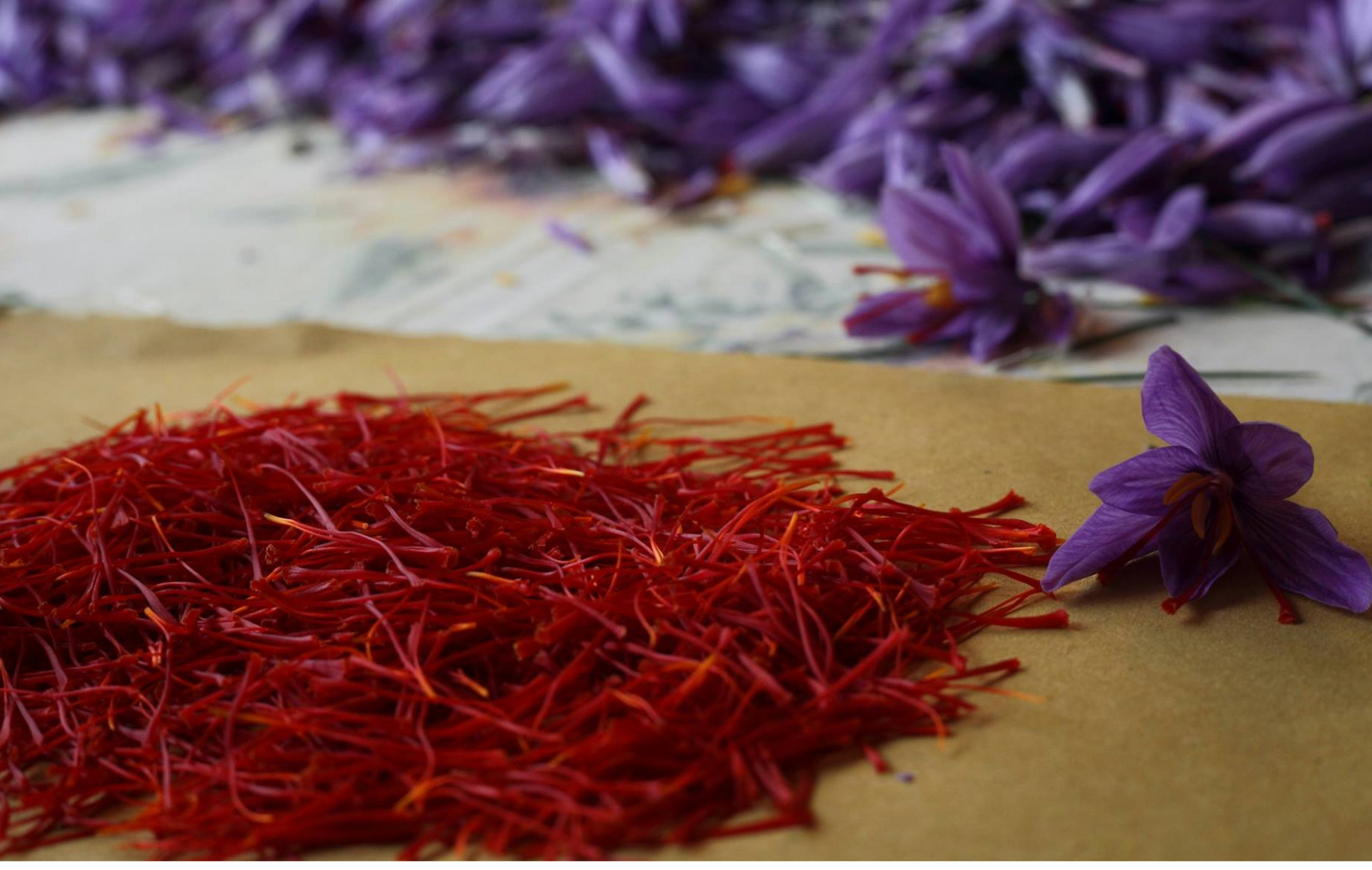
Titolo diapositiva
Scrivi qui la tua didascaliaPulsante
-
Saffron from S. Gimignano
San Gimignano and Its Connection to Saffron
San Gimignano is an extraordinary example of a medieval town that has remained intact in its urban layout and architectural structures. It is located on a hill 334 meters high, at the crossroads of the Via Francigena and the road connecting Siena to Pisa. The town experienced significant growth during the Middle Ages thanks to its strategic position and the agricultural wealth of the surrounding territory. Among the most prized products of the area is saffron, known as "red gold" for its high economic and cultural value.
Saffron: A Precious Spice as Valuable as Gold
Saffron has been widespread in Europe since the Middle Ages and originates from the Middle East. Its name comes from the Arabic-Persian word za’faran, which refers to the golden-yellow color typical of this spice. Saffron comes from the Crocus sativus flower, a member of the Crocus family, which was once also used as a medicinal plant for a wide range of ailments. Each flower has three red stigmas, measuring between 25 and 30 millimeters long, which, once harvested and dried, become the spice.
Saffron Production
Saffron has been known for millennia and is part of numerous culinary traditions worldwide. The main producing countries in ancient times (Iran, Spain, India, and Greece) still dominate the global market today. However, saffron is also cultivated in Italy, with some excellent varieties such as Abruzzo saffron and San Gimignano saffron (SI), both of which have the PDO (Protected Designation of Origin) label. San Gimignano saffron is protected by a Consortium and has been produced since the 1200s, when it was used, along with the Florentine florin, to pay municipal debts. Other prominent producing regions include Sardinia, Umbria, and Marche.
Why Is It So Expensive?
With a price that can exceed €65,000 per kilo, saffron is the most expensive spice in the world, surpassing even vanilla. This high value is justified by the harvesting process, which requires great care and manual skill to avoid breaking the delicate filaments. To obtain 1 kg of saffron, around 150,000 flowers and approximately 400 hours of labor are needed for harvesting and drying. Additionally, during the drying process, Crocus sativus filaments lose about 4/5 of their weight.
To ensure the highest quality and prevent counterfeiting, San Gimignano saffron is sold exclusively in whole stigmas, which have an intense dark red color, inside packages bearing the PDO seal. Currently, the annual production is around 60–70 kg, cultivated on an area of 6 to 7 hectares.
How to Use It
Saffron is used both as a seasoning and as a natural coloring agent, containing more than 150 volatile compounds, including safranal, an essential oil that gives it its unmistakable aroma. It can be purchased in powder form, to be added directly to dishes, or in stigmas, which must be soaked in hot water for a few hours to fully release their fragrance. It is used in numerous culinary preparations, from first courses to meat dishes, sauces, and baked goods, including muffins, shortcrust pastry, and zuccotto cake. Additionally, saffron is found in liqueurs and in the production of sheep’s milk cheeses.
Beyond its culinary uses, this spice has important pharmacological properties: it aids digestion, has calming and analgesic effects, and acts as an antioxidant; it stimulates metabolism and strengthens the immune system. Not surprisingly, since the Middle Ages, it has also been used in painting and as a trading commodity. As early as the 1200s, at the gates of San Gimignano, there were official “weighers” responsible for checking the quantities of saffron entering and leaving the town, while other officials—speziali, circatori, and taratori—ensured its quality and set its price.
Saffron Cultivation
Growing Crocus sativus is a good way to obtain saffron at a lower cost. The bulb flowers in a few weeks: it is planted at the end of summer and harvested in October. This plant prefers well-drained soil rich in organic matter, thrives in sunlight but not humidity, and withstands frost well. One hundred bulbs can produce about 1 gram of saffron in the first year of cultivation, with a progressive increase in the following years. After harvesting, the filaments must be dried and stored in a cool, dark place.
31/1/2025
Saffron from S. Gimignano
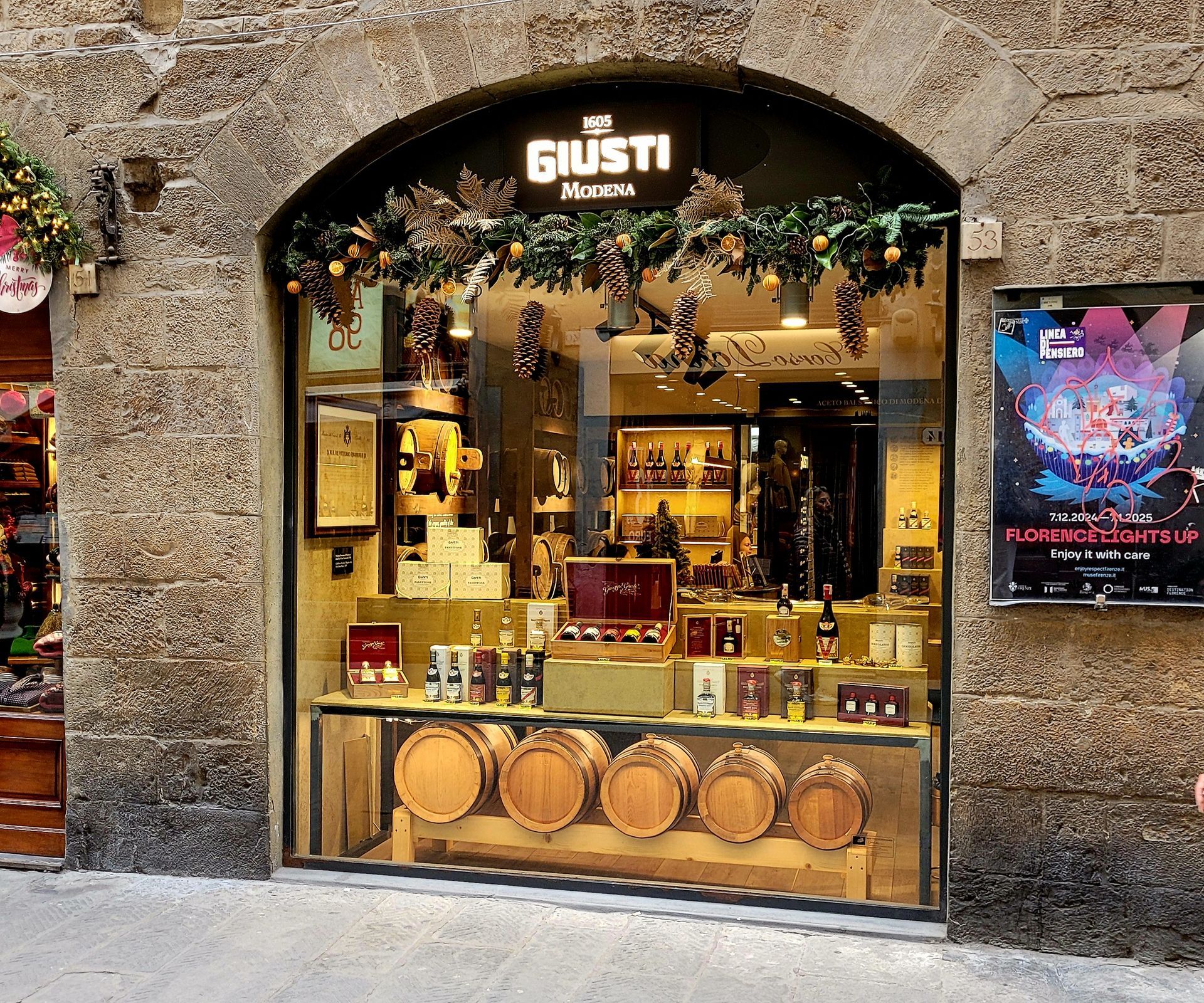
Titolo diapositiva
Scrivi qui la tua didascaliaPulsante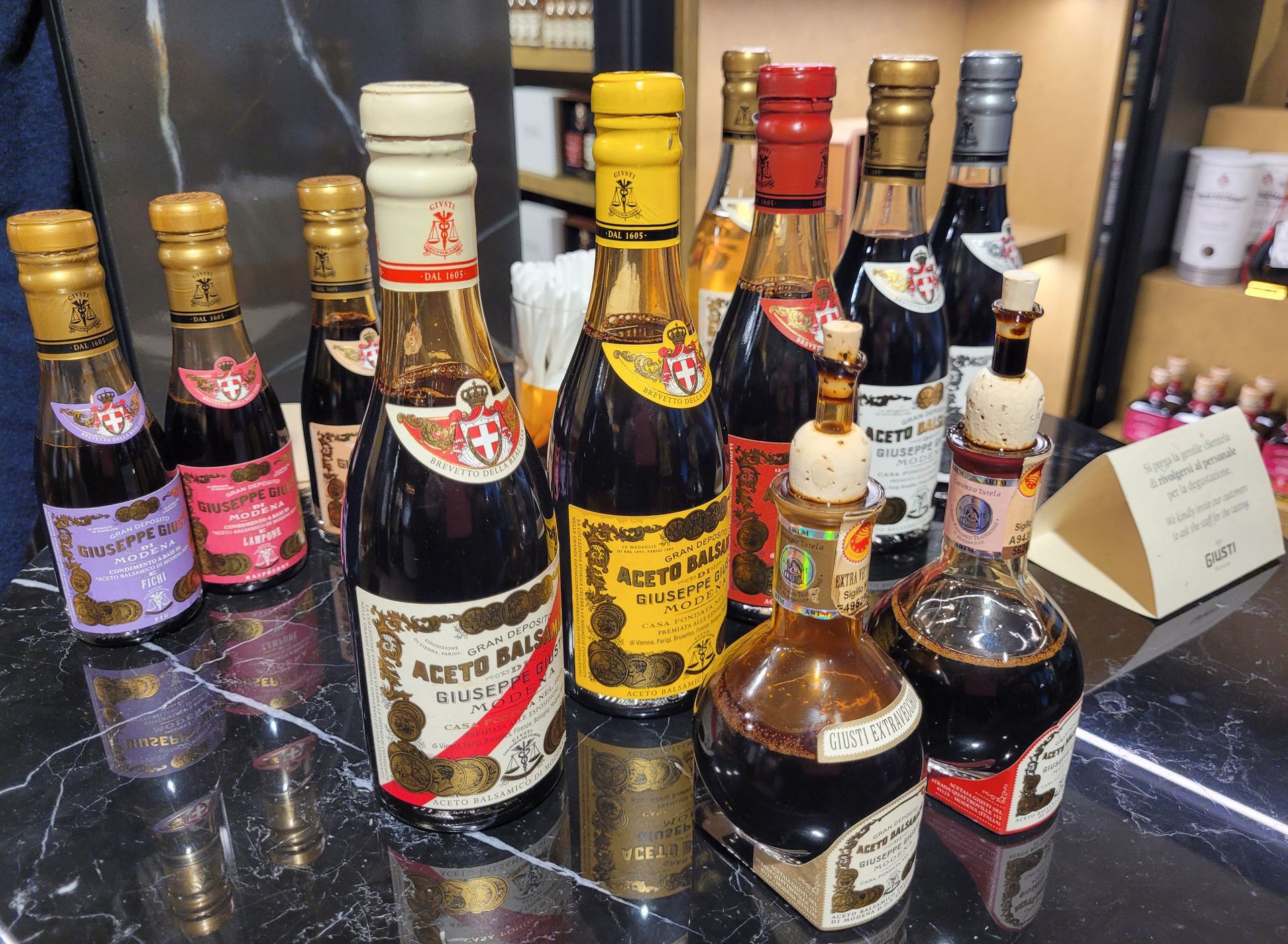
Titolo diapositiva
Scrivi qui la tua didascaliaPulsante
Titolo diapositiva
Scrivi qui la tua didascaliaPulsante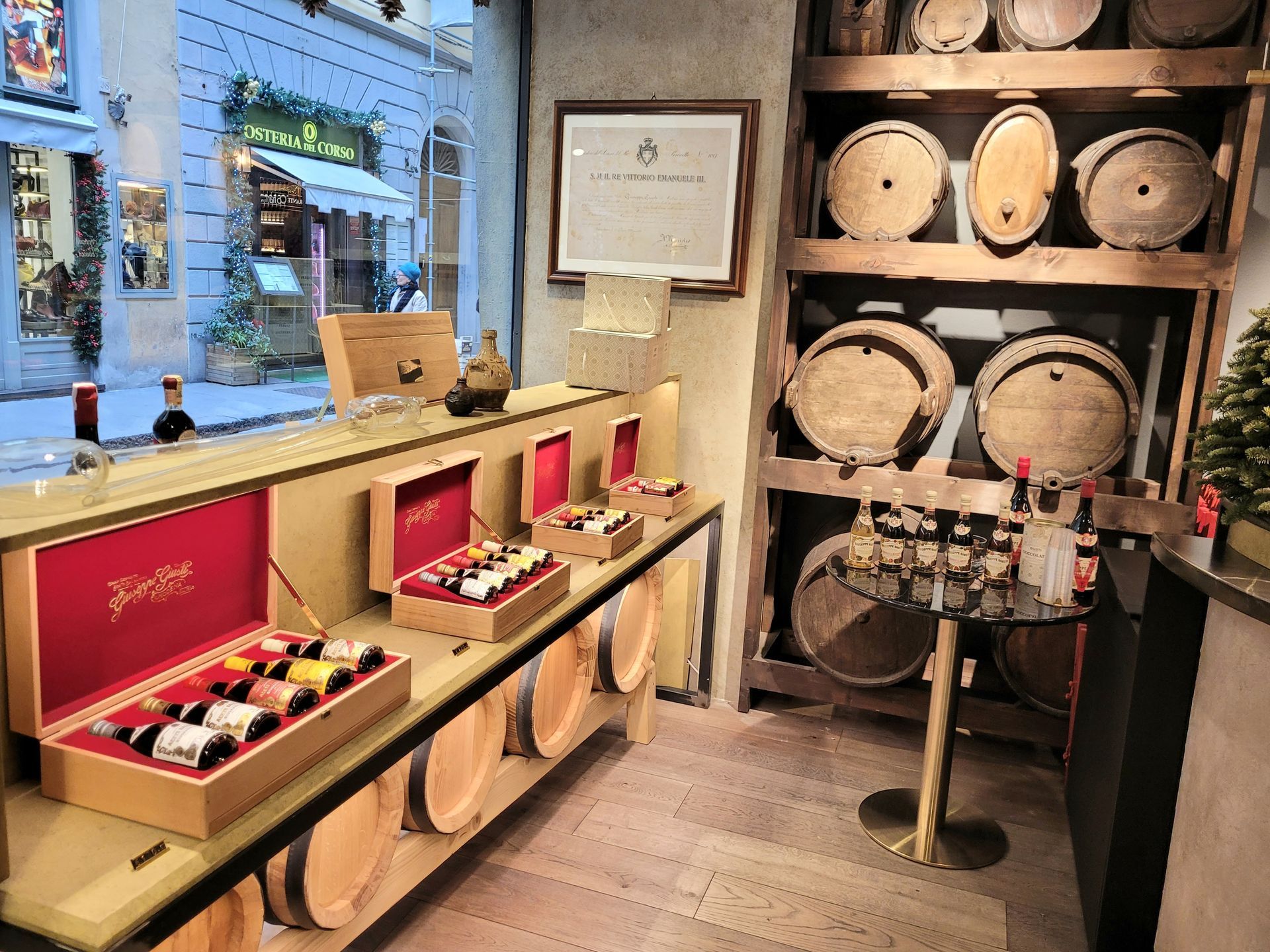
Titolo diapositiva
Scrivi qui la tua didascaliaPulsante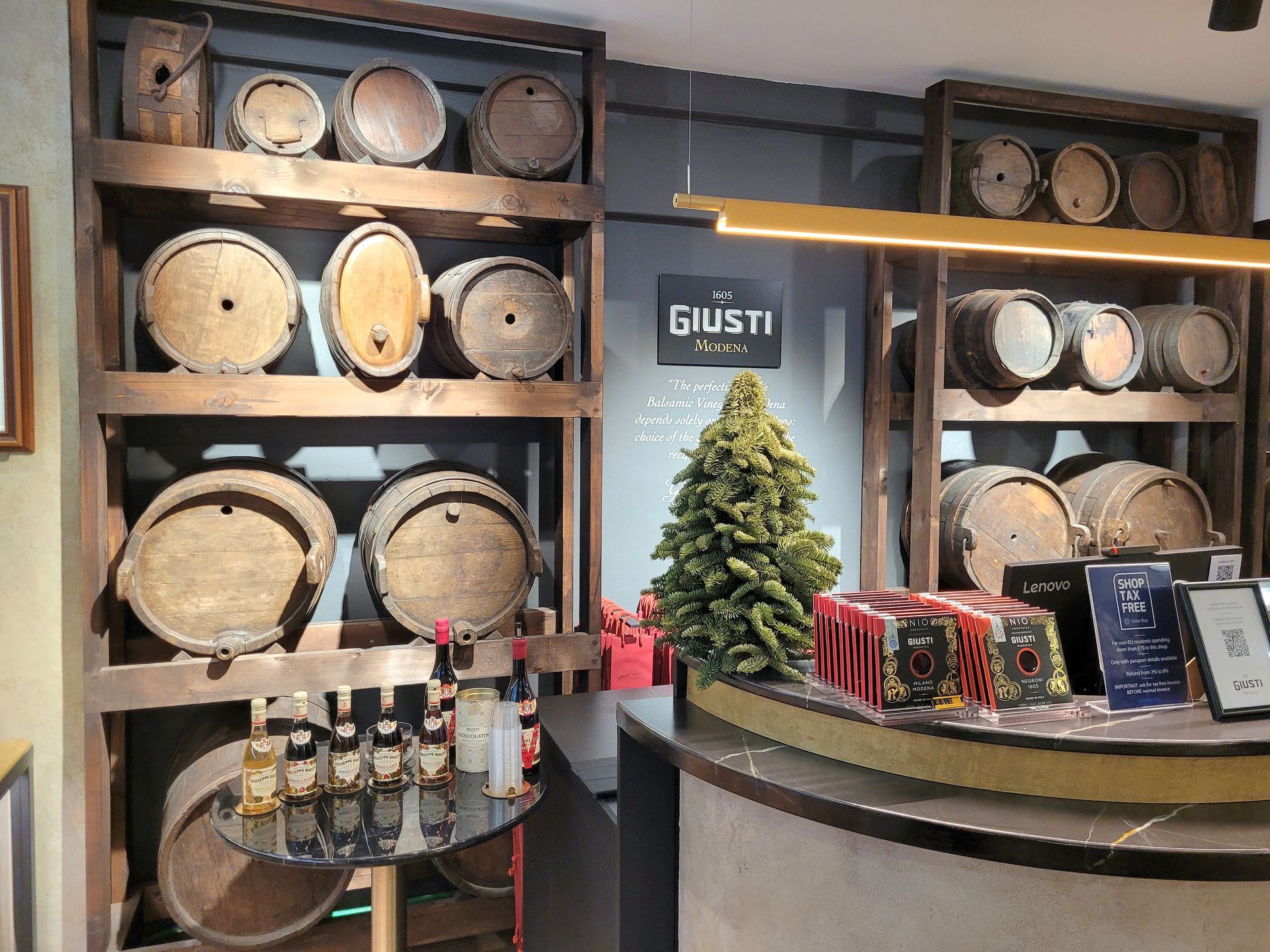
Titolo diapositiva
Scrivi qui la tua didascaliaPulsante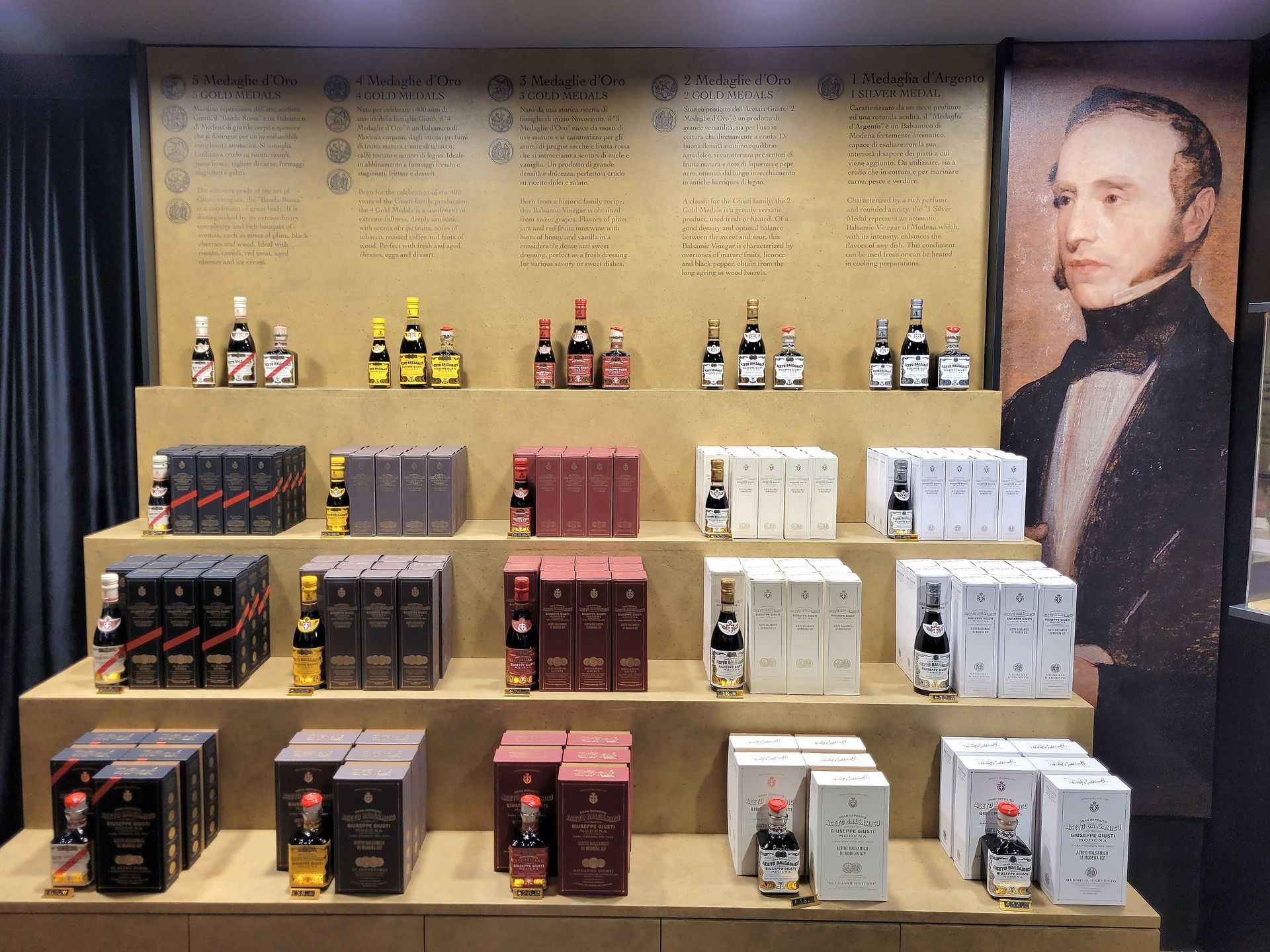
Titolo diapositiva
Scrivi qui la tua didascaliaPulsante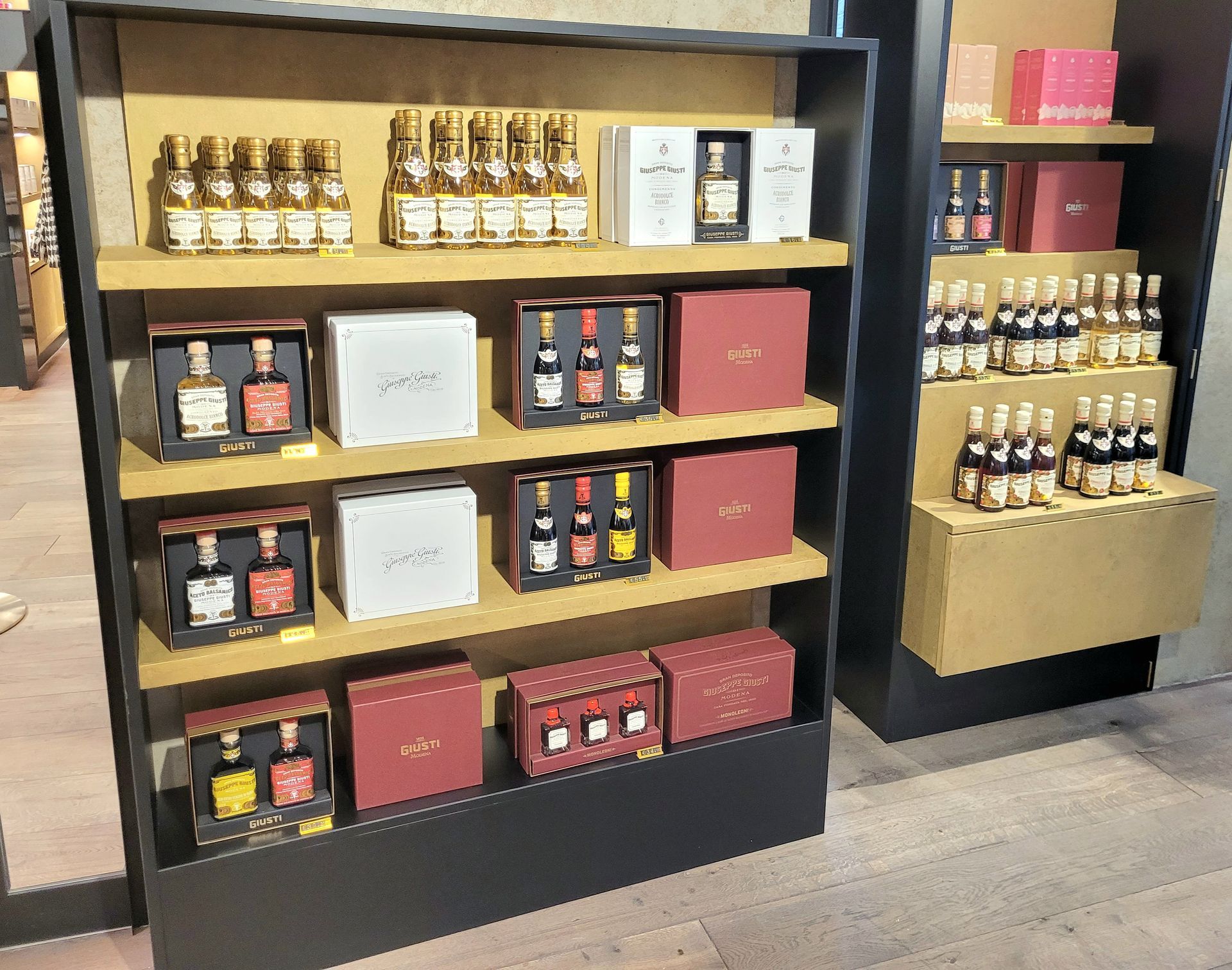
Titolo diapositiva
Scrivi qui la tua didascaliaPulsante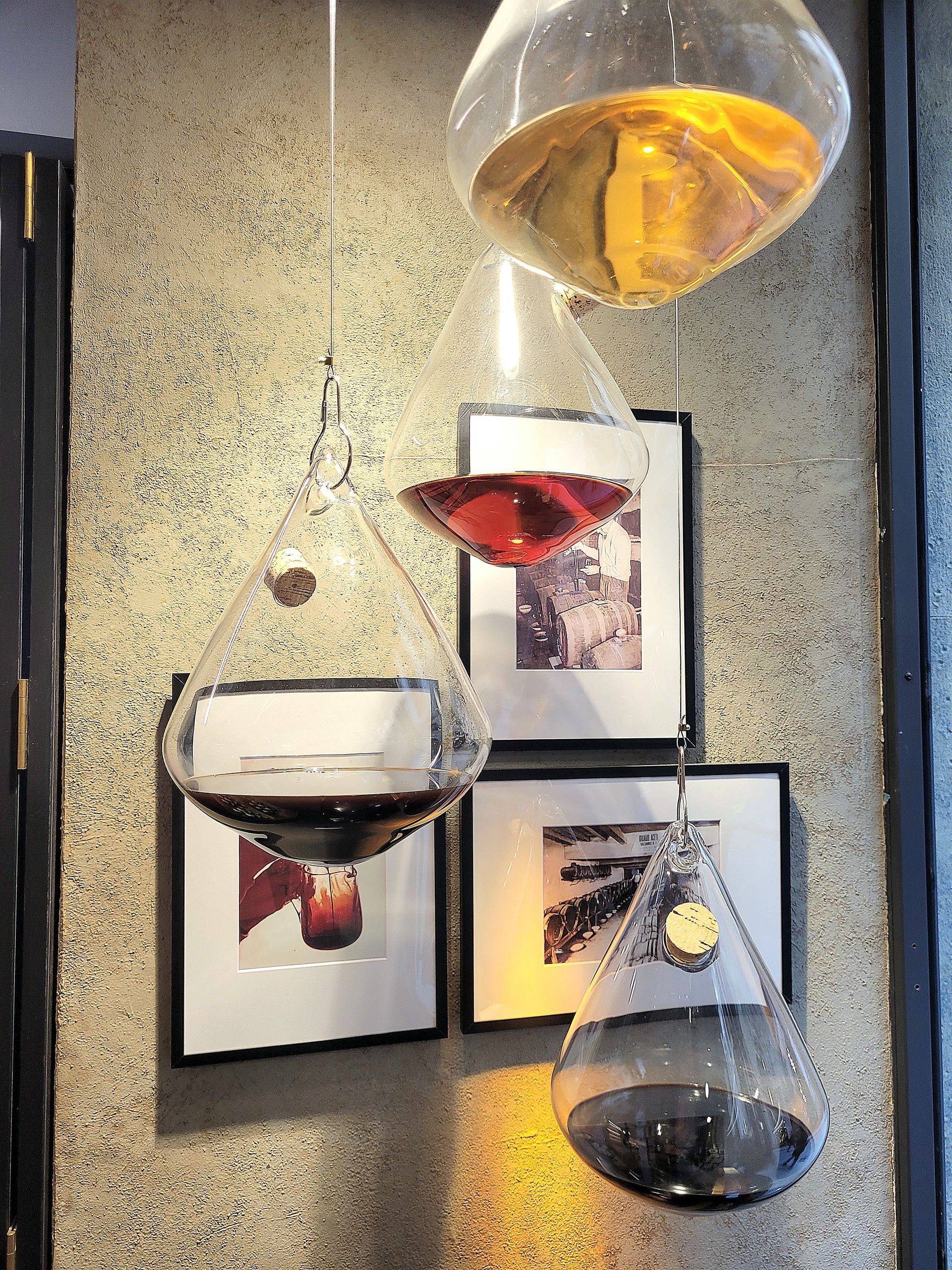
Titolo diapositiva
Scrivi qui la tua didascaliaPulsante
-
Balsamic Vinegar Giusti
It’s not a typical Tuscan product, but it has become such an excellence of "Made in Italy" that we are delighted to talk about Aceto Balsamico Giusti, which has opened a store – referred to as a “boutique” by the company – in Florence, at Via del Corso 53.
The Acetaia Giusti, founded in 1605, is recognized as the oldest and most prestigious producer of Traditional Balsamic Vinegar of Modena in Italy.
The Giusti family has passed down the art of balsamic vinegar production for generations, preserving the centuries-old artisanal techniques. One of the secrets to the acetaia’s success is the "Giusti Recipe," codified in 1863 by Giuseppe Giusti, a historic document establishing the principles for creating balsamic vinegar of the highest quality. This is achieved through careful selection of raw materials, long aging in fine wooden barrels, and respect for the time needed for proper maturation.
Already in 1900, by participating in fairs and world exhibitions, the company received numerous awards. The medals won on those occasions still adorn Giusti vinegar labels today, attesting to their historical excellence.
A unique aspect of the Acetaia Giusti is its extraordinary collection of historic barrels, some dating back to the 17th century, which give the product its unmistakable flavors and aromas. These barrels, passed down from generation to generation, are meticulously preserved in the historic acetaia in Modena, a place that represents a true "cathedral of taste."
Today, the Acetaia Giusti is managed by the seventeenth generation of the family, who continue to preserve the authenticity and quality of the product while combining tradition and innovation.
The Types of Giusti Vinegar
The Acetaia Giusti produces a range of balsamic vinegars, each with unique characteristics tied to the aging process, the type of wood used for the barrels, and the specific recipe:
Traditional Balsamic Vinegar of Modena DOP
This is the flagship product, made exclusively from cooked must of local grapes. The vinegar is aged for at least 12 years in barrels made from different woods (oak, chestnut, cherry, juniper), which impart complex aromas and a balanced sweet-and-sour taste. There is also an Extravecchio version, aged for a minimum of 25 years, offering even more intense and velvety notes.
Balsamic Vinegar of Modena PGI
This vinegar is known for its versatility, ranging from younger products, ideal for salads and marinades, to aged ones, perfect for meats, aged cheeses, or desserts. The Giusti line includes various levels of aging and density, each with a unique aromatic profile.
Balsamic Condiments
These are sweeter and creamier products, made from high-quality musts without the addition of caramel or preservatives, ideal for enhancing gourmet dishes. Among them is the famous Riccardo Giusti, aged for a long time and prized for its notes of plum and vanilla.
Flavored Vinegars
An innovative line that combines balsamic vinegar with natural flavors such as truffle, figs, citrus, or aromatic herbs, designed to accompany specific dishes or create original pairings.
Balsamic Pearls
Gelatin spheres filled with balsamic vinegar, ideal for decorating and enhancing high-end dishes, from finger foods to desserts.
Aceto Balsamico Giusti
Via del Corso 53
Firenze
12/12/2025
Balsamic Vinegar Giusti



